
A man talks on his mobile phone while standing near a conventional telephone box, which stands empty. Enabling technology for mobile phones was first developed in the 1940s but it was not until the mid-1980s that they became widely available. By 2011, it was estimated in Britain that more calls were made using mobile phones than wired devices.[1]
The history of mobile phones covers mobile communication devices that connect wirelessly to the public switched telephone network.
While the transmission of speech by signal has a long history, the first devices that were wireless, mobile, and also capable of connecting to the standard telephone network are much more recent. The first such devices were barely portable compared to today’s compact hand-held devices, and their use was clumsy.
Drastic changes have taken place in both the networking of wireless communication and the prevalence of its use, with smartphones becoming common globally and a growing proportion of Internet access now done via mobile broadband.
Foundations[edit]
Predecessors[edit]
In 1908, Professor Albert Jahn and the Oakland Transcontinental Aerial Telephone and Power Company claimed to have developed a wireless telephone. They were accused of fraud and the charge was then dropped, but they do not really seem to have proceeded with production.[2] In 1917 the Finnish inventor Eric Tigerstedt successfully filed a patent for a «pocket-size folding telephone with a very thin carbon microphone». Beginning in 1918, the German railroad system tested wireless telephony on military trains between Berlin and Zossen.[3] In 1924 public trials started with telephone connection on trains between Berlin and Hamburg. In 1925 the company Zugtelephonie AG was founded to supply train-telephony equipment and, in 1926 telephone service in trains of the Deutsche Reichsbahn and the German mail service on the route between Hamburg and Berlin was approved and offered to first-class travelers.[4]

Karl Arnold drawing of public use of mobile telephones.
Fiction anticipated the development of real-world mobile telephones. In 1906 the English caricaturist Lewis Baumer published a cartoon in Punch entitled «Forecasts for 1907»[4] in which he showed a man and a woman in London’s Hyde Park each separately engaged in gambling and dating on wireless-telegraphy equipment.[5] In 1923 Ilya Ehrenburg casually listed «pocket telephones» among the achievements of contemporary technology in a story in his collection Thirteen Pipes (Russian: Тринадцать трубок).[6] In 1926 the artist Karl Arnold drew a visionary cartoon about the use of mobile phones in the street, in the picture «wireless telephony», published in the German satirical magazine Simplicissimus.[7]
The Second World War (1939-1945) saw the military use of radio-telephony links. Hand-held radio transceivers have been available since the 1940s. Mobile telephones for automobiles became available from some telephone companies in the 1940s. Early devices were bulky, consumed large amounts of power, and the network supported only a few simultaneous conversations. (Modern cellular networks allow automatic and pervasive use of mobile phones for voice- and data-communication.)
In the United States, engineers from Bell Labs began work on a system to allow mobile users to place and receive telephone calls from automobiles, leading to the inauguration of mobile service on 17 June 1946 in St. Louis, Missouri. Shortly after, AT&T offered Mobile Telephone Service. A wide range of mostly incompatible mobile-telephone services offered limited coverage areas and only a few available channels in urban areas. As calls were transmitted as unencrypted analog signals, anyone with radio equipment that could receive those frequencies could eavesdrop. The commercial introduction (in Japan in 1979) of cellular technology, which allowed re-use of frequencies many times in small adjacent areas covered by relatively low-powered transmitters, made widespread adoption of mobile telephones economically feasible.
In the USSR, Leonid Kupriyanovich, an engineer from Moscow, developed and presented a number of experimental pocket-sized communications radios in 1957–1961. The weight of one model, presented in 1961, was only 70 g and could fit in a palm.[8][9] However, in the USSR the decision at first to develop the system of the automobile «Altai» phone was made[by whom?].[10]
In 1965 the Bulgarian company «Radioelektronika» presented a mobile automatic phone combined with a base station at the Inforga-65 international exhibition in Moscow. Solutions of this phone were based on a system developed by Leonid Kupriyanovich. One base station, connected to one telephone wire line, could serve up to 15 customers.[11]
Advances in mobile telephony can be traced in successive generations from the early «0G» services like MTS and its successor Improved Mobile Telephone Service, to first-generation (1G) analog cellular networks (1979–), second-generation (2G) digital cellular networks (1991–), third-generation (3G) broadband data services (launched commercially in 2001) to the fourth-generation (4G) native-IP networks (launched in 2006 in South Korea). 5G began deployment in 2019.
Early services[edit]
MTS[edit]
In 1949, AT&T commercialized Mobile Telephone Service. From its start in St. Louis, Missouri, in 1946, AT&T introduced Mobile Telephone Service to one hundred towns and highway corridors by 1948. Mobile Telephone Service was a rarity with only 5,000 customers placing about 30,000 calls each week. Calls were set up manually by an operator and the user had to depress a button on the handset to speak and release the button to listen. The call subscriber equipment weighed about 80 pounds (36 kg)[12]
Subscriber growth and revenue generation were hampered by the constraints of the technology. Because only three radio channels were available, only three customers in any given city could make mobile telephone calls at one time.[13] Mobile Telephone Service was expensive, costing US$15 per month, plus $0.30–0.40 per local call, equivalent to (in 2012 US dollars) about $176 per month and $3.50–4.75 per call.[12]
In the UK, there was also a vehicle-based system called «Post Office Radiophone Service,»[14] which was launched around the city of Manchester in 1959, and although it required callers to speak to an operator, it was possible to be put through to any subscriber in Great Britain. The service was extended to London in 1965 and other major cities in 1972.
IMTS[edit]
AT&T introduced the first major improvement to mobile telephony in 1965, giving the improved service the obvious name of Improved Mobile Telephone Service. IMTS used additional radio channels, allowing more simultaneous calls in a given geographic area, introduced customer dialing, eliminating manual call setup by an operator, and reduced the size and weight of the subscriber equipment.[12]
Despite the capacity improvement offered by IMTS, demand outstripped capacity. In agreement with state regulatory agencies, AT&T limited the service to just 40,000 customers system wide. In New York City, for example, 2,000 customers shared just 12 radio channels and typically had to wait 30 minutes to place a call.[12]
Radio Common Carrier[edit]

A mobile radio telephone.
Radio Common Carrier[15] or RCC was a service introduced in the 1960s by independent telephone companies to compete against AT&T’s IMTS. RCC systems used paired UHF 454/459 MHz and VHF 152/158 MHz frequencies near those used by IMTS. RCC based services were provided until the 1980s when cellular AMPS systems made RCC equipment obsolete.
Some RCC systems were designed to allow customers of adjacent carriers to use their facilities, but equipment used by RCCs did not allow the equivalent of modern «roaming» because technical standards were not uniform. For example, the phone of an Omaha, Nebraska–based RCC service would not be likely to work in Phoenix, Arizona. Roaming was not encouraged, in part, because there was no centralized industry billing database for RCCs. Signaling formats were not standardized. For example, some systems used two-tone sequential paging to alert a mobile of an incoming call. Other systems used DTMF. Some used Secode 2805, which transmitted an interrupted 2805 Hz tone (similar to IMTS signaling) to alert mobiles of an offered call. Some radio equipment used with RCC systems was half-duplex, push-to-talk LOMO equipment such as Motorola hand-helds or RCA 700-series conventional two-way radios. Other vehicular equipment had telephone handsets and rotary dials or pushbutton pads, and operated full duplex like a conventional wired telephone. A few users had full-duplex briefcase telephones (radically advanced for their day)
At the end of RCC’s existence, industry associations were working on a technical standard that would have allowed roaming, and some mobile users had multiple decoders to enable operation with more than one of the common signaling formats (600/1500, 2805, and Reach). Manual operation was often a fallback for RCC roamers.
Other services[edit]
In 1969 Penn Central Railroad equipped commuter trains along the 360 kilometres (220 mi) New York-Washington route with special pay phones that allowed passengers to place telephone calls while the train was moving. The system re-used six frequencies in the 450 MHz band in nine sites.[13]
In the UK, Channel Islands and elsewhere the «Rabbit» phone system was briefly used, being a hybrid of «cell» base stations and handsets. One major limitation was that you had to be less than 300 feet (closer with buildings) from a base due to power limitations on a portable device.
With modern technology a similar variant is being considered for Apple’s new 4G «smart watch» so they can be used in large events in a broadly similar way to a femtocell.
European mobile radio networks[edit]
In Europe, several mutually incompatible mobile radio services were developed.
In 1966 Norway had a system called OLT which was manually controlled. Finland’s ARP, launched in 1971, was also manual as was the Swedish MTD. All were replaced by the automatic NMT, (Nordic Mobile Telephone) system in the early 1980s.
In July 1971 Readycall was introduced in London by Burndept after obtaining a special concession to break the Post Office monopoly to allow selective calling to mobiles of calls from the public telephone system. This system was available to the public for a subscription of £16 month. A year later the service was extended to two other UK towns.[16]
West Germany had a network called A-Netz launched in 1952 as the country’s first public commercial mobile phone network. In 1972 this was displaced by B-Netz which connected calls automatically.
Cellular concept[edit]

A multi-directional, cellular network antenna array («cell tower»).
In December 1947, Douglas H. Ring and W. Rae Young, Bell Labs engineers, proposed hexagonal cells for mobile phones in vehicles.[17] At this stage, the technology to implement these ideas did not exist, nor had the frequencies been allocated. Two decades would pass before Richard H. Frenkiel, Joel S. Engel and Philip T. Porter of Bell Labs expanded the early proposals into a much more detailed system plan. It was Porter who first proposed that the cell towers use the now-familiar directional antennas to reduce interference and increase channel reuse (see picture at right)[18] Porter also invented the dial-then-send method used by all cell phones to reduce wasted channel time.
In all these early examples, a mobile phone had to stay within the coverage area serviced by one base station throughout the phone call, i.e. there was no continuity of service as the phones moved through several cell areas. The concepts of frequency reuse and handoff, as well as a number of other concepts that formed the basis of modern cell phone technology, were described in the late 1960s, in papers by Frenkiel and Porter. In 1970 Amos E. Joel, Jr., a Bell Labs engineer,[19] invented a «three-sided trunk circuit» to aid in the «call handoff» process from one cell to another. His patent contained an early description of the Bell Labs cellular concept, but as switching systems became faster, such a circuit became unnecessary and was never implemented in a system.
A cellular telephone switching plan was described by Fluhr and Nussbaum in 1973,[20] and a cellular telephone data signaling system was described in 1977 by Hachenburg et al.[21]
Emergence of automated services[edit]
The first fully automated mobile phone system for vehicles was launched in Sweden in 1956. Named MTA (Mobiltelefonisystem A), it allowed calls to be made and received in the car using a rotary dial. The car phone could also be paged. Calls from the car were direct dial, whereas incoming calls required an operator to locate the nearest base station to the car. It was developed by Sture Laurén and other engineers at Televerket network operator. Ericsson provided the switchboard while Svenska Radioaktiebolaget (SRA) and Marconi provided the telephones and base station equipment. MTA phones consisted of vacuum tubes and relays, and weighed 40 kilograms (88 lb). In 1962, an upgraded version called Mobile System B (MTB) was introduced. This was a push-button telephone, and used transistors and DTMF signaling to improve its operational reliability. In 1971 the MTD version was launched, opening for several different brands of equipment and gaining commercial success.[22][23] The network remained open until 1983 and still had 600 customers when it closed.
In 1958 development began on a similar system for motorists in the USSR.[24] The «Altay» national civil mobile phone service was based on Soviet MRT-1327 standard. The main developers of the Altay system were the Voronezh Science Research Institute of Communications (VNIIS) and the State Specialized Project Institute (GSPI). In 1963 the service started in Moscow, and by 1970 was deployed in 30 cities across the USSR. Versions of the Altay system are still in use today as a trunking system in some parts of Russia.
In 1959 a private telephone company in Brewster, Kansas, USA, the S&T Telephone Company, (still in business today) with the use of Motorola Radio Telephone equipment and a private tower facility, offered to the public mobile telephone services in that local area of NW Kansas. This system was a direct dial up service through their local switchboard, and was installed in many private vehicles including grain combines, trucks, and automobiles. For some as yet unknown reason, the system, after being placed online and operated for a very brief time period, was shut down. The management of the company was immediately changed, and the fully operable system and related equipment was immediately dismantled in early 1960, not to be seen again.[citation needed]
In 1966, Bulgaria presented the pocket mobile automatic phone RAT-0,5 combined with a base station RATZ-10 (RATC-10) on Interorgtechnika-66 international exhibition. One base station, connected to one telephone wire line, could serve up to six customers.[25]
One of the first successful public commercial mobile phone networks was the ARP network in Finland, launched in 1971. Posthumously, ARP is sometimes viewed as a zero generation (0G) cellular network, being slightly above previous proprietary and limited coverage networks.[citation needed]
Handheld mobile phone[edit]

Martin Cooper photographed in 2007 with his 1972 handheld mobile phone prototype.
Prior to 1973, mobile telephony was limited to phones installed in cars and other vehicles.[19] Motorola was the first company to produce a handheld mobile phone. On 3 April 1973, Martin Cooper, a Motorola researcher and executive, made the first mobile telephone call from handheld subscriber equipment, placing a call to Dr. Joel S. Engel of Bell Labs, his rival.[26][27][28] The prototype handheld phone used by Dr. Cooper weighed 2 kilograms (4.4 lb) and measured 23 by 13 by 4.5 centimetres (9.1 by 5.1 by 1.8 in). The prototype offered a talk time of just 30 minutes and took 10 hours to re-charge.[29]
John F. Mitchell,[30][31][32] Motorola’s chief of portable communication products and Cooper’s boss in 1973, played a key role in advancing the development of handheld mobile telephone equipment. Mitchell successfully pushed Motorola to develop wireless communication products that would be small enough to use anywhere and participated in the design of the cellular phone.[33][34]
Early generations[edit]
Newer technology has been developed and rolled out in a series of waves or generations. The «generation» terminology only became widely used when 3G was launched, but is now used retrospectively when referring to the earlier systems.
1G – Analog cellular[edit]
Main article: 1G
The first automatic analog cellular systems ever deployed were NTT’s system first used in 1979 for car phones in Tokyo (and later the rest of the country of Japan), and the NMT system which was released in the Nordic countries in 1981.
The first analog cellular system widely deployed in North America was the Advanced Mobile Phone System (AMPS).[12] It was commercially introduced in the Americas on 13 October 1983, Israel in 1986, and Australia in 1987. AMPS was a pioneering technology that helped drive mass market usage of cellular technology, but it had several serious issues by modern standards. It was unencrypted and easily vulnerable to eavesdropping via a scanner; it was susceptible to cell phone «cloning» and it used a Frequency-division multiple access (FDMA) scheme and required significant amounts of wireless spectrum to support.
On 6 March 1983, the DynaTAC 8000X mobile phone launched on the first US 1G network by Ameritech. It cost $100M to develop, and took over a decade to reach the market.[35] The phone had a talk time of just thirty minutes and took ten hours to charge. Consumer demand was strong despite the battery life, weight, and low talk time, and waiting lists were in the thousands.[36][37]
Many of the iconic early commercial cell phones such as the Motorola DynaTAC Analog AMPS were eventually superseded by Digital AMPS (D-AMPS) in 1990, and AMPS service was shut down by most North American carriers by 2008.
In February 1986 Australia launched its Cellular Telephone System by Telecom Australia. Peter Reedman was the first Telecom Customer to be connected on 6 January 1986 along with five other subscribers as test customers prior to the official launch date of 28 February.
2G – Digital cellular[edit]

Two 1991 GSM mobile phones with several AC adapters.
In the 1990s, the ‘second generation’ mobile phone systems emerged. Two systems competed for supremacy in the global market: the European developed GSM standard and the U.S. developed CDMA standard. These differed from the previous generation by using digital instead of analog transmission, and also fast out-of-band phone-to-network signaling. The rise in mobile phone usage as a result of 2G was explosive and this era also saw the advent of prepaid mobile phones.
In 1991 the first GSM network (Radiolinja) launched in Finland. In general the frequencies used by 2G systems in Europe were higher than those in the United States, though with some overlap. For example, the 900 MHz frequency range was used for both 1G and 2G systems in Europe, so the 1G systems were rapidly closed down to make space for the 2G systems. In the United States, the IS-54 standard was deployed in the same band as AMPS and displaced some of the existing analog channels.
In 1993, IBM Simon was introduced. This was possibly the world’s first smartphone. It was a mobile phone, pager, fax machine, and PDA all rolled into one. It included a calendar, address book, clock, calculator, notepad, email, and a touchscreen with a QWERTY keyboard.[38] The IBM Simon had a stylus, used to tap the touch screen. It featured predictive typing that would guess the next characters as you tapped. It had applications, or at least a way to deliver more features by plugging a PCMCIA 1.8 MB memory card into the phone.[39]
Coinciding with the introduction of 2G systems was a trend away from the larger «brick» phones toward tiny 100–200 grams (3.5–7.1 oz) hand-held devices. This change was possible not only through technological improvements such as more advanced batteries and more energy-efficient electronics, but also because of the higher density of cell sites to accommodate increasing usage. The latter meant that the average distance transmission from phone to the base station shortened, leading to increased battery life while on the move.
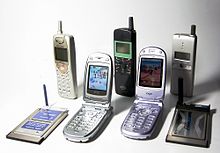
The second generation introduced a new variant of communication called SMS or text messaging. It was initially available only on GSM networks but spread eventually on all digital networks. The first machine-generated SMS message was sent in the UK on 3 December 1992 followed in 1993 by the first person-to-person SMS sent in Finland. The advent of prepaid services in the late 1990s soon made SMS the communication method of choice among the young, a trend which spread across all ages.
2G also introduced the ability to access media content on mobile phones. In 1998 the first downloadable content sold to mobile phones was the ring tone, launched by Finland’s Radiolinja (now Elisa). Advertising on the mobile phone first appeared in Finland when a free daily SMS news headline service was launched in 2000, sponsored by advertising.
Mobile payments were trialed in 1998 in Finland and Sweden where a mobile phone was used to pay for a Coca-Cola vending machine and car parking. Commercial launches followed in 1999 in Norway. The first commercial payment system to mimic banks and credit cards was launched in the Philippines in 1999 simultaneously by mobile operators Globe and Smart.
The first full internet service on mobile phones was introduced by NTT DoCoMo in Japan in 1999.
3G – Mobile broadband[edit]
Main article: 3G
As the use of 2G phones became more widespread and people began to use mobile phones in their daily lives, it became clear that demand for data (such as access to browse the internet) was growing. Further, experience from fixed broadband services showed there would also be an ever-increasing demand for greater data speeds. The 2G technology was nowhere near up to the job, so the industry began to work on the next generation of technology known as 3G. The main technological difference that distinguishes 3G technology from 2G technology is the use of packet switching rather than circuit switching for data transmission.[40] In addition, the standardization process focused on requirements more than technology (2 Mbit/s maximum data rate indoors, 384 kbit/s outdoors, for example).
Inevitably this led to many competing standards with different contenders pushing their own technologies, and the vision of a single unified worldwide standard looked far from reality. The standard 2G CDMA networks became 3G compliant with the adoption of Revision A to EV-DO, which made several additions to the protocol while retaining backwards compatibility:
- Introduction of several new forward link data rates that increase the maximum burst rate from 2.45 Mbit/s to 3.1 Mbit/s
- Protocols that would decrease connection establishment time
- Ability for more than one mobile to share the same time slot
- Introduction of QoS flags
All these were put in place to allow for low latency, low bit rate communications such as VoIP.[41]
The first pre-commercial trial network with 3G was launched by NTT DoCoMo in Japan in the Tokyo region in May 2001. NTT DoCoMo launched the first commercial 3G network on 1 October 2001, using the WCDMA technology. In 2002 the first 3G networks on the rival CDMA2000 1xEV-DO technology were launched by SK Telecom and KTF in South Korea, and Monet in the US. Monet has since gone bankrupt. By the end of 2002, the second WCDMA network was launched in Japan by Vodafone KK (now Softbank). European launches of 3G were in Italy and the UK by Three/Hutchison group, on WCDMA. 2003 saw a further eight commercial launches of 3G, six more on WCDMA and two more on the EV-DO standard.
During the development of 3G systems, 2.5G systems such as CDMA2000 1x and GPRS were developed as extensions to existing 2G networks. These provide some of the features of 3G without fulfilling the promised high data rates or full range of multimedia services. CDMA2000-1X delivers theoretical maximum data speeds of up to 307 kbit/s. Just beyond these is the EDGE system which in theory covers the requirements for 3G system, but is so narrowly above these that any practical system would be sure to fall short.
The high connection speeds of 3G technology enabled a transformation in the industry: for the first time, media streaming of radio (and even television) content to 3G handsets became possible,[42] with companies such as RealNetworks[43] and Disney[44] among the early pioneers in this type of offering.
In the mid-2000s, an evolution of 3G technology began to be implemented, namely High-Speed Downlink Packet Access (HSDPA). It is an enhanced 3G (third generation) mobile telephony communication protocol in the High-Speed Packet Access (HSPA) family, also coined 3.5G, 3G+ or turbo 3G, which allows networks based on Universal Mobile Telecommunications System (UMTS) to have higher data transfer speeds and capacity. Current HSDPA deployments support down-link speeds of 1.8, 3.6, 7.2 and 14.0 Mbit/s.
By the end of 2007, there were 295 million subscribers on 3G networks worldwide, which reflected 9% of the total worldwide subscriber base. About two thirds of these were on the WCDMA standard and one third on the EV-DO standard. The 3G telecoms services generated over $120 billion of revenues during 2007 and at many markets the majority of new phones activated were 3G phones. In Japan and South Korea the market no longer supplies phones of the second generation.
Although mobile phones had long had the ability to access data networks such as the Internet, it was not until the widespread availability of good quality 3G coverage in the mid-2000s (decade) that specialized devices appeared to access the mobile web. The first such devices, known as «dongles», plugged directly into a computer through the USB port. Another new class of device appeared subsequently, the so-called «compact wireless router» such as the Novatel MiFi, which makes 3G Internet connectivity available to multiple computers simultaneously over Wi-Fi, rather than just to a single computer via a USB plug-in.
Such devices became especially popular for use with laptop computers due to the added portability they bestow. Consequently, some computer manufacturers started to embed the mobile data function directly into the laptop so a dongle or MiFi wasn’t needed. Instead, the SIM card could be inserted directly into the device itself to access the mobile data services. Such 3G-capable laptops became commonly known as «netbooks». Other types of data-aware devices followed in the netbook’s footsteps. By the beginning of 2010, E-readers, such as the Amazon Kindle and the Nook from Barnes & Noble, had already become available with embedded wireless Internet, and Apple had announced plans for embedded wireless Internet on its iPad tablet devices later that year.
4G – Native IP networks[edit]
Main article: 4G

By 2009, it had become clear that, at some point, 3G networks would be overwhelmed by the growth of bandwidth-intensive applications like streaming media.[45] Consequently, the industry began looking to data-optimized 4th-generation technologies, with the promise of speed improvements up to 10-fold over existing 3G technologies. The first two commercially available technologies billed as 4G were the WiMAX standard (offered in the U.S. by Sprint) and the LTE standard, first offered in Scandinavia by TeliaSonera.
One of the main ways in which 4G differed technologically from 3G was in its elimination of circuit switching, instead employing an all-IP network. Thus, 4G ushered in a treatment of voice calls just like any other type of streaming audio media, using packet switching over Internet, LAN or WAN networks via VoIP.[46]
5G – Cellular Mobile Communications[edit]
Main article: 5G

«5G» is the next version of cellular mobile telephone standards. The 5G standards include millimetre-band radio spectrum to allow data speeds up to 1 gigabit per second, and reduce latency (the processing time to handle a data transmission) between handset and network to a few milliseconds. 5G standards also include low-band and mid-band spectrum similar to existing networks. Telephone companies are introducing 5G technology starting in 2019.
Mobile device charger standards[edit]
| Port | Current | Voltage | Power (max) |
|---|---|---|---|
| Micro-USB | 500 mA | 5 V | 2.5 W |
| 1 A | 5 V | 5 W | |
| 2 A | 5 V | 10 W | |
| USB-C[47] | 100 mA to 3 A | 5 V | 15 W |
| 1.7 A to 3 A | 9 V | 27 W | |
| 1.8 A to 3 A | 15 V | 45 W | |
| 2.25 A to 5 A | 20 V | 100 W |

Mobile phone charger plugs prior to the universal standard (left to right) Samsung E900, Motorola V3, Nokia 6101 and Sony Ericsson K750.


The USB-C interface is increasingly found on (chargers for) smartphones.[48]
Before a universal charger standard was agreed upon in the late 2000s users needed an adapter which was often proprietary by brand or manufacturer to charge their battery. Later, mobile phones from major brands typically used a USB cable with a micro-USB or, since the mid-2010s, USB-C interface. Apple’s iPhone is the sole major brand to retain its own interface (30-pin dock connector replaced by Lightning in 2012).
In China[edit]
As of 14 June 2007, all new mobile phones applying for a license in China are required to use a USB port as a power port for battery charging.[49][50] This was the first standard to use the convention of shorting D+ and D−.[51]
OMTP/GSMA Universal Charging Solution[edit]
In September 2007, the Open Mobile Terminal Platform group (a forum of mobile network operators and manufacturers such as Nokia, Samsung, Motorola, Sony Ericsson, and LG) announced that its members had agreed on Micro-USB as the future common connector for mobile devices.[52][53]
The GSM Association (GSMA) followed suit on 17 February 2009,[54][55][56][57] and on 22 April 2009, this was further endorsed by the CTIA – The Wireless Association,[58] with the International Telecommunication Union (ITU) announcing on 22 October 2009 that it had also embraced the Universal Charging Solution as its «energy-efficient one-charger-fits-all new mobile phone solution,» and added: «Based on the Micro-USB interface, UCS chargers will also include a 4-star or higher efficiency rating—up to three times more energy-efficient than an unrated charger.»[59]
EU smartphone power supply standard[edit]
In June 2009, many of the world’s largest mobile phone manufacturers signed an EC-sponsored Memorandum of Understanding (MoU), agreeing to make most data-enabled mobile phones marketed in the European Union compatible with a common External Power Supply (common EPS). The EU’s common EPS specification (EN 62684:2010) references the USB Battery Charging Specification and is similar to the GSMA/OMTP and Chinese charging solutions.[60][61] In January 2011, the International Electrotechnical Commission (IEC) released its version of the (EU’s) common EPS standard as IEC 62684:2011.[62]
Satellite mobile[edit]
As well as the now-common cellular phone, there is also the very different approach of connecting directly from the handset to an Earth-orbiting satellite. Such mobile phones can be used in remote areas out of reach of wired networks or where construction of a cellular network is uneconomic.
The Inmarsat system is the oldest, originally developed in 1979 for safety of life at sea, and uses a series of satellites in geostationary orbits to cover the majority of the globe. Several smaller operators use the same approach with just one or two satellites to provide a regional service. An alternative approach is to use a series of low Earth orbit satellites much closer to Earth. This is the basis of the Iridium and Globalstar satellite phone services.
See also[edit]
- The Mobile Revolution
- Autopatch
- History of prepaid mobile phones
- History of the telephone
- List of best-selling mobile phones
- Personal Communications Service PCS
- Pager
- Babylonokia
- SIM card
- Smartphone § History
 Telephones portal
Telephones portal
References[edit]
- ^ Wallop, Harry (18 June 2011). «Mobile phone calls overtake landline calls for first time». The Daily Telegraph. London. Archived from the original on 12 January 2022. Retrieved 20 October 2019.
- ^ «Wireless Phone Cases Dismissed». San Francisco Call. Vol. 104, no. 37. 7 July 1908. Retrieved 21 October 2013 – via California Digital Newspaper Collection.
- ^ «von 1900 bis 1999» [from 1900 to 1999]. Deutsches Telefon Museum (in German). 29 December 2007. Retrieved 28 May 2013.
- ^ a b «The development of digital mobile communications in Germany». Informatikzentrum Mobilfunk (IZMF). Archived from the original on 30 July 2013. Retrieved 30 May 2013.
- ^ Baumer, Lewis (1906). «Forecasts for 1907». Punch.
- ^ Published by «Геликон» in Berlin.
- ^ Arnold, Karl (1926). «Drahtlose Telephonie» (PDF). Simplicissimus. Vol. 31, no. 38. p. 498.
- ^ Рыбчинский, Юрий (December 1961). Радиофон [Radiophone]. Орловская Правда (in Russian). Мoscow.
- ^ Izmerov, Oleg. «Отечественные Мобильники 50-Х» [Domestic Mobile Phones of the 50’s]. Окно В Прошлое (in Russian).
- ^ «Nauka i zhizn» magazine, 8, 1957 and 10, 1958; «Technika-molodezhi» magazine, 2, 1959; «Za rulem» magazine, 12, 1957, «Yuny technik» magazine, 7, 1957, 2, 1958 and 9, 1996; «Orlovskaya pravda» newspaper, 12, 1961.
- ^ «Nauka i zhizn» magazine, 8, 1965.
- ^ a b c d e «1946: First Mobile Telephone Call». AT&T Labs. 2011. Archived from the original on 12 December 2012. Retrieved 24 April 2012.
- ^ a b Gow, Gordon A. & Smith, Richard K. (2006). Mobile and wireless communications: an introduction. Maidenhead: McGraw-Hill International (UK). p. 23. ISBN 0-335-21761-3.
- ^ «Car radiophone paved way for mobiles». BT Today. 28 October 2009. Archived from the original on 8 August 2014.
- ^ Code of Federal Regulations: Telecommunications. Washington, DC: Office of the Federal Register. 1 October 1992.
- ^ Wireless World, July 1971.
- ^ «1947 memo by Douglas H. Ring proposing hexagonal cells» (PDF). Privateline.com. Archived from the original (PDF) on 7 February 2012. Retrieved 30 December 2012.
- ^ Farley, Tom (1 January 2006). «Cellular Telephone Basics». Privateline.com. Archived from the original on 5 December 2015. Retrieved 30 December 2012.
- ^ a b See Amos Joel patent 3,663,762.
- ^ Fluhr, Zachary C. & Nussbaum, Eric (November 1973). «Switching Plan for a Cellular Mobile Telephone System». IEEE Transactions on Communications. 21 (11): 1281–1286.
- ^ Hachenburg, V.; Holm, B.D. & Smith, J.I. (1977). «Data signaling functions for a cellular mobile telephone system». IEEE Transactions on Vehicular Technology. 26: 82–88. doi:10.1109/T-VT.1977.23660. S2CID 9138183.
- ^ Shi, Mingtao (2007). Technology Base of mobile cellular operators in Germany and China. Univerlagtuberlin. pp. 55–. ISBN 978-3-7983-2057-4. Retrieved 30 December 2012.
- ^ «Facts about the Mobile. A Journey through Time» (PDF). Mobilen50ar.se. Archived from the original (PDF) on 13 August 2010.
- ^ «First Russian Mobile Phone». EnglishRussia.com. 18 September 2006. Retrieved 30 December 2012.
- ^ «Radio» magazine, 2, 1967; «Novosti dnya» newsreel, 37, 1966.
- ^ Shiels, Maggie (21 April 2003). «A chat with the man behind mobiles». BBC News.
- ^ Martin Cooper, et al., «Radio Telephone System», US Patent number 3,906,166; Filing date: 17 October 1973; Issue date: September 1975; Assignee Motorola
- ^ «Motorola Demonstrates Portable Telephone» (PDF). Motorola Communications Division press release. 3 April 1979.
- ^ «Martin Cooper – The Inventor of the Cell Phone». Cellular.co.za. Archived from the original on 23 November 2015. Retrieved 23 March 2012.
- ^ «John F. Mitchell Biography». Brophy.net. 7 August 2012. Retrieved 30 December 2012.
- ^ «The Top Giants in Telephony». History of the Cell Phone.com. 11 June 2009. Archived from the original on 17 January 2013. Retrieved 30 December 2012.
- ^ «Who invented the cell phone?». Brophy.net. 7 August 2012. Retrieved 30 December 2012.
- ^ Miller, Stephen (20 June 2009). «Motorola Executive Helped spur Cellphone Revolution, Oversaw Ill-fated Iridium Project». The Wall Street Journal.
- ^ Lane, Clare (17 June 2009). «John F. Mitchell, 1928–2009: Was president of Motorola from 1980 to ’95». Chicago Tribune. Archived from the original on 6 July 2009. Retrieved 29 July 2009.
- ^ «First Cell Phone a True ‘Brick’«. NBC News. Associated Press. 11 April 2005. Retrieved 21 March 2012.
- ^ «Motorola DynaTAC 8000x: This is the Original Mobile Phone Design Icon». Retrobrick. Archived from the original on 22 October 2006. Retrieved 21 March 2012.
- ^ A. Kling, Andrew (2010). Cell Phones. Farmington Hills, MI: Lucent Books. pp. 24–26.
- ^ «Cell Phone Generations 1G, 2G, 3G and now 4G». Tech Forums. 25 August 2010. Retrieved 16 October 2012.
- ^ Sager, Ira (29 June 2012). «Before IPhone and Android Came Simon, the First Smartphone». Bloomberg Businessweek. Retrieved 16 October 2012.
- ^ «3G and Cellular radio Information». Privateline.com. 23 January 2005. Archived from the original on 15 January 2010. Retrieved 30 December 2012.
- ^ Gopal, Thawatt (11–15 March 2007). «EVDO Rev. A Control Channel Bandwidth Analysis for Paging». IEEE Wireless Communications and Networking Conference. IEEE. pp. 3262–3267. doi:10.1109/WCNC.2007.601. ISBN 978-1-4244-0658-6.
- ^ Yapp, Edwin (20 September 2005). «Mobile TV, anyone?». The Star. Archived from the original on 28 April 2006. Retrieved 16 October 2012.
- ^ Gonsalves, Antone (19 September 2005). «RealNetworks Launches Streaming Music on Sprint Phones». Information Week. Retrieved 16 October 2012.
- ^ «Disney will offer mobile content». Media Week. 20 September 2005. Archived from the original on 2 September 2012. Retrieved 16 October 2012.
- ^ Saeed, Fahd Ahmad. «Capacity Limit Problem in 3G Networks». Purdue School of Engineering. Retrieved 23 April 2010.
- ^ «VoIP Support in Nokia Devices». Nokia Forum. Archived from the original on 28 May 2009. Retrieved 16 August 2009.
- ^ «10 Power Rules». Universal Serial Bus Power Delivery Specification revision 3.0, version 1.1. USB Implementers Forum. Retrieved 5 September 2017.
- ^ «USB Type-C footprint expands across market segments». IHS Technology. Retrieved 7 August 2019.
- ^ Cai Yan (31 May 2007). «China to enforce universal cell phone charger». EE Times. Retrieved 25 August 2007.
- ^ The Chinese FCC’s technical standard: «YD/T 1591-2006, Technical Requirements and Test Method of Charger and Interface for Mobile Telecommunication Terminal Equipment» (PDF). Dian yuan (in Chinese).
- ^ Lam, Crystal; Liu, Harry (22 October 2007). «How to conform to China’s new mobile phone interface standards». EE Times. Retrieved 22 June 2010.
- ^ «Pros seem to outdo cons in new phone charger standard». News.com. 20 September 2007. Retrieved 26 November 2007.
- ^ «Broad Manufacturer Agreement Gives Universal Phone Cable Green Light». Open Mobile Terminal Platform (Press release). 17 September 2007. Archived from the original on 29 June 2009. Retrieved 26 November 2007.
- ^ «Agreement on Mobile phone Standard Charger». GSM World (Press release). Archived from the original on 17 February 2009. Retrieved 3 December 2017.
- ^ «Common Charging and Local Data Connectivity». Open Mobile Terminal Platform. 11 February 2009. Archived from the original on 29 March 2009. Retrieved 11 February 2009.
- ^ «Universal Charging Solution». GSM World. Archived from the original on 26 June 2010. Retrieved 22 June 2010.
- ^ «Meeting the challenge of the universal charge standard in mobile phones». Planet Analog. Archived from the original on 9 September 2012. Retrieved 22 June 2010.
- ^ «The Wireless Association Announces One Universal Charger Solution to Celebrate Earth Day». CTIA (Press release). 22 April 2009. Archived from the original on 14 December 2010. Retrieved 22 June 2010.
- ^ «Universal phone charger standard approved». ITU (Press release). 22 October 2009. Archived from the original on 23 December 2009. Retrieved 22 June 2010.
- ^ «Chargers». European Commission. 29 June 2009. Retrieved 22 June 2010.
- ^ «Europe gets universal cellphone charger in 2010». Wired. 13 June 2009. Retrieved 22 June 2010.
- ^ «One size-fits-all mobile phone charger: IEC publishes first globally relevant standard». International Electrotechnical Commission. 1 February 2011. Retrieved 20 February 2012.
Further reading[edit]
- Agar, Jon (2004). Constant Touch: a Global History of the Mobile Phone. Cambridge: Icon. ISBN 978-1-84046-541-9.
- Farley, Tom (2007). «The Cell-Phone Revolution». American Heritage of Invention & Technology. 22 (3): 8–19. ISSN 8756-7296. OCLC 108126426. BL Shelfmark 0817.734000.

A man talks on his mobile phone while standing near a conventional telephone box, which stands empty. Enabling technology for mobile phones was first developed in the 1940s but it was not until the mid-1980s that they became widely available. By 2011, it was estimated in Britain that more calls were made using mobile phones than wired devices.[1]
The history of mobile phones covers mobile communication devices that connect wirelessly to the public switched telephone network.
While the transmission of speech by signal has a long history, the first devices that were wireless, mobile, and also capable of connecting to the standard telephone network are much more recent. The first such devices were barely portable compared to today’s compact hand-held devices, and their use was clumsy.
Drastic changes have taken place in both the networking of wireless communication and the prevalence of its use, with smartphones becoming common globally and a growing proportion of Internet access now done via mobile broadband.
Foundations[edit]
Predecessors[edit]
In 1908, Professor Albert Jahn and the Oakland Transcontinental Aerial Telephone and Power Company claimed to have developed a wireless telephone. They were accused of fraud and the charge was then dropped, but they do not really seem to have proceeded with production.[2] In 1917 the Finnish inventor Eric Tigerstedt successfully filed a patent for a «pocket-size folding telephone with a very thin carbon microphone». Beginning in 1918, the German railroad system tested wireless telephony on military trains between Berlin and Zossen.[3] In 1924 public trials started with telephone connection on trains between Berlin and Hamburg. In 1925 the company Zugtelephonie AG was founded to supply train-telephony equipment and, in 1926 telephone service in trains of the Deutsche Reichsbahn and the German mail service on the route between Hamburg and Berlin was approved and offered to first-class travelers.[4]

Karl Arnold drawing of public use of mobile telephones.
Fiction anticipated the development of real-world mobile telephones. In 1906 the English caricaturist Lewis Baumer published a cartoon in Punch entitled «Forecasts for 1907»[4] in which he showed a man and a woman in London’s Hyde Park each separately engaged in gambling and dating on wireless-telegraphy equipment.[5] In 1923 Ilya Ehrenburg casually listed «pocket telephones» among the achievements of contemporary technology in a story in his collection Thirteen Pipes (Russian: Тринадцать трубок).[6] In 1926 the artist Karl Arnold drew a visionary cartoon about the use of mobile phones in the street, in the picture «wireless telephony», published in the German satirical magazine Simplicissimus.[7]
The Second World War (1939-1945) saw the military use of radio-telephony links. Hand-held radio transceivers have been available since the 1940s. Mobile telephones for automobiles became available from some telephone companies in the 1940s. Early devices were bulky, consumed large amounts of power, and the network supported only a few simultaneous conversations. (Modern cellular networks allow automatic and pervasive use of mobile phones for voice- and data-communication.)
In the United States, engineers from Bell Labs began work on a system to allow mobile users to place and receive telephone calls from automobiles, leading to the inauguration of mobile service on 17 June 1946 in St. Louis, Missouri. Shortly after, AT&T offered Mobile Telephone Service. A wide range of mostly incompatible mobile-telephone services offered limited coverage areas and only a few available channels in urban areas. As calls were transmitted as unencrypted analog signals, anyone with radio equipment that could receive those frequencies could eavesdrop. The commercial introduction (in Japan in 1979) of cellular technology, which allowed re-use of frequencies many times in small adjacent areas covered by relatively low-powered transmitters, made widespread adoption of mobile telephones economically feasible.
In the USSR, Leonid Kupriyanovich, an engineer from Moscow, developed and presented a number of experimental pocket-sized communications radios in 1957–1961. The weight of one model, presented in 1961, was only 70 g and could fit in a palm.[8][9] However, in the USSR the decision at first to develop the system of the automobile «Altai» phone was made[by whom?].[10]
In 1965 the Bulgarian company «Radioelektronika» presented a mobile automatic phone combined with a base station at the Inforga-65 international exhibition in Moscow. Solutions of this phone were based on a system developed by Leonid Kupriyanovich. One base station, connected to one telephone wire line, could serve up to 15 customers.[11]
Advances in mobile telephony can be traced in successive generations from the early «0G» services like MTS and its successor Improved Mobile Telephone Service, to first-generation (1G) analog cellular networks (1979–), second-generation (2G) digital cellular networks (1991–), third-generation (3G) broadband data services (launched commercially in 2001) to the fourth-generation (4G) native-IP networks (launched in 2006 in South Korea). 5G began deployment in 2019.
Early services[edit]
MTS[edit]
In 1949, AT&T commercialized Mobile Telephone Service. From its start in St. Louis, Missouri, in 1946, AT&T introduced Mobile Telephone Service to one hundred towns and highway corridors by 1948. Mobile Telephone Service was a rarity with only 5,000 customers placing about 30,000 calls each week. Calls were set up manually by an operator and the user had to depress a button on the handset to speak and release the button to listen. The call subscriber equipment weighed about 80 pounds (36 kg)[12]
Subscriber growth and revenue generation were hampered by the constraints of the technology. Because only three radio channels were available, only three customers in any given city could make mobile telephone calls at one time.[13] Mobile Telephone Service was expensive, costing US$15 per month, plus $0.30–0.40 per local call, equivalent to (in 2012 US dollars) about $176 per month and $3.50–4.75 per call.[12]
In the UK, there was also a vehicle-based system called «Post Office Radiophone Service,»[14] which was launched around the city of Manchester in 1959, and although it required callers to speak to an operator, it was possible to be put through to any subscriber in Great Britain. The service was extended to London in 1965 and other major cities in 1972.
IMTS[edit]
AT&T introduced the first major improvement to mobile telephony in 1965, giving the improved service the obvious name of Improved Mobile Telephone Service. IMTS used additional radio channels, allowing more simultaneous calls in a given geographic area, introduced customer dialing, eliminating manual call setup by an operator, and reduced the size and weight of the subscriber equipment.[12]
Despite the capacity improvement offered by IMTS, demand outstripped capacity. In agreement with state regulatory agencies, AT&T limited the service to just 40,000 customers system wide. In New York City, for example, 2,000 customers shared just 12 radio channels and typically had to wait 30 minutes to place a call.[12]
Radio Common Carrier[edit]

A mobile radio telephone.
Radio Common Carrier[15] or RCC was a service introduced in the 1960s by independent telephone companies to compete against AT&T’s IMTS. RCC systems used paired UHF 454/459 MHz and VHF 152/158 MHz frequencies near those used by IMTS. RCC based services were provided until the 1980s when cellular AMPS systems made RCC equipment obsolete.
Some RCC systems were designed to allow customers of adjacent carriers to use their facilities, but equipment used by RCCs did not allow the equivalent of modern «roaming» because technical standards were not uniform. For example, the phone of an Omaha, Nebraska–based RCC service would not be likely to work in Phoenix, Arizona. Roaming was not encouraged, in part, because there was no centralized industry billing database for RCCs. Signaling formats were not standardized. For example, some systems used two-tone sequential paging to alert a mobile of an incoming call. Other systems used DTMF. Some used Secode 2805, which transmitted an interrupted 2805 Hz tone (similar to IMTS signaling) to alert mobiles of an offered call. Some radio equipment used with RCC systems was half-duplex, push-to-talk LOMO equipment such as Motorola hand-helds or RCA 700-series conventional two-way radios. Other vehicular equipment had telephone handsets and rotary dials or pushbutton pads, and operated full duplex like a conventional wired telephone. A few users had full-duplex briefcase telephones (radically advanced for their day)
At the end of RCC’s existence, industry associations were working on a technical standard that would have allowed roaming, and some mobile users had multiple decoders to enable operation with more than one of the common signaling formats (600/1500, 2805, and Reach). Manual operation was often a fallback for RCC roamers.
Other services[edit]
In 1969 Penn Central Railroad equipped commuter trains along the 360 kilometres (220 mi) New York-Washington route with special pay phones that allowed passengers to place telephone calls while the train was moving. The system re-used six frequencies in the 450 MHz band in nine sites.[13]
In the UK, Channel Islands and elsewhere the «Rabbit» phone system was briefly used, being a hybrid of «cell» base stations and handsets. One major limitation was that you had to be less than 300 feet (closer with buildings) from a base due to power limitations on a portable device.
With modern technology a similar variant is being considered for Apple’s new 4G «smart watch» so they can be used in large events in a broadly similar way to a femtocell.
European mobile radio networks[edit]
In Europe, several mutually incompatible mobile radio services were developed.
In 1966 Norway had a system called OLT which was manually controlled. Finland’s ARP, launched in 1971, was also manual as was the Swedish MTD. All were replaced by the automatic NMT, (Nordic Mobile Telephone) system in the early 1980s.
In July 1971 Readycall was introduced in London by Burndept after obtaining a special concession to break the Post Office monopoly to allow selective calling to mobiles of calls from the public telephone system. This system was available to the public for a subscription of £16 month. A year later the service was extended to two other UK towns.[16]
West Germany had a network called A-Netz launched in 1952 as the country’s first public commercial mobile phone network. In 1972 this was displaced by B-Netz which connected calls automatically.
Cellular concept[edit]

A multi-directional, cellular network antenna array («cell tower»).
In December 1947, Douglas H. Ring and W. Rae Young, Bell Labs engineers, proposed hexagonal cells for mobile phones in vehicles.[17] At this stage, the technology to implement these ideas did not exist, nor had the frequencies been allocated. Two decades would pass before Richard H. Frenkiel, Joel S. Engel and Philip T. Porter of Bell Labs expanded the early proposals into a much more detailed system plan. It was Porter who first proposed that the cell towers use the now-familiar directional antennas to reduce interference and increase channel reuse (see picture at right)[18] Porter also invented the dial-then-send method used by all cell phones to reduce wasted channel time.
In all these early examples, a mobile phone had to stay within the coverage area serviced by one base station throughout the phone call, i.e. there was no continuity of service as the phones moved through several cell areas. The concepts of frequency reuse and handoff, as well as a number of other concepts that formed the basis of modern cell phone technology, were described in the late 1960s, in papers by Frenkiel and Porter. In 1970 Amos E. Joel, Jr., a Bell Labs engineer,[19] invented a «three-sided trunk circuit» to aid in the «call handoff» process from one cell to another. His patent contained an early description of the Bell Labs cellular concept, but as switching systems became faster, such a circuit became unnecessary and was never implemented in a system.
A cellular telephone switching plan was described by Fluhr and Nussbaum in 1973,[20] and a cellular telephone data signaling system was described in 1977 by Hachenburg et al.[21]
Emergence of automated services[edit]
The first fully automated mobile phone system for vehicles was launched in Sweden in 1956. Named MTA (Mobiltelefonisystem A), it allowed calls to be made and received in the car using a rotary dial. The car phone could also be paged. Calls from the car were direct dial, whereas incoming calls required an operator to locate the nearest base station to the car. It was developed by Sture Laurén and other engineers at Televerket network operator. Ericsson provided the switchboard while Svenska Radioaktiebolaget (SRA) and Marconi provided the telephones and base station equipment. MTA phones consisted of vacuum tubes and relays, and weighed 40 kilograms (88 lb). In 1962, an upgraded version called Mobile System B (MTB) was introduced. This was a push-button telephone, and used transistors and DTMF signaling to improve its operational reliability. In 1971 the MTD version was launched, opening for several different brands of equipment and gaining commercial success.[22][23] The network remained open until 1983 and still had 600 customers when it closed.
In 1958 development began on a similar system for motorists in the USSR.[24] The «Altay» national civil mobile phone service was based on Soviet MRT-1327 standard. The main developers of the Altay system were the Voronezh Science Research Institute of Communications (VNIIS) and the State Specialized Project Institute (GSPI). In 1963 the service started in Moscow, and by 1970 was deployed in 30 cities across the USSR. Versions of the Altay system are still in use today as a trunking system in some parts of Russia.
In 1959 a private telephone company in Brewster, Kansas, USA, the S&T Telephone Company, (still in business today) with the use of Motorola Radio Telephone equipment and a private tower facility, offered to the public mobile telephone services in that local area of NW Kansas. This system was a direct dial up service through their local switchboard, and was installed in many private vehicles including grain combines, trucks, and automobiles. For some as yet unknown reason, the system, after being placed online and operated for a very brief time period, was shut down. The management of the company was immediately changed, and the fully operable system and related equipment was immediately dismantled in early 1960, not to be seen again.[citation needed]
In 1966, Bulgaria presented the pocket mobile automatic phone RAT-0,5 combined with a base station RATZ-10 (RATC-10) on Interorgtechnika-66 international exhibition. One base station, connected to one telephone wire line, could serve up to six customers.[25]
One of the first successful public commercial mobile phone networks was the ARP network in Finland, launched in 1971. Posthumously, ARP is sometimes viewed as a zero generation (0G) cellular network, being slightly above previous proprietary and limited coverage networks.[citation needed]
Handheld mobile phone[edit]

Martin Cooper photographed in 2007 with his 1972 handheld mobile phone prototype.
Prior to 1973, mobile telephony was limited to phones installed in cars and other vehicles.[19] Motorola was the first company to produce a handheld mobile phone. On 3 April 1973, Martin Cooper, a Motorola researcher and executive, made the first mobile telephone call from handheld subscriber equipment, placing a call to Dr. Joel S. Engel of Bell Labs, his rival.[26][27][28] The prototype handheld phone used by Dr. Cooper weighed 2 kilograms (4.4 lb) and measured 23 by 13 by 4.5 centimetres (9.1 by 5.1 by 1.8 in). The prototype offered a talk time of just 30 minutes and took 10 hours to re-charge.[29]
John F. Mitchell,[30][31][32] Motorola’s chief of portable communication products and Cooper’s boss in 1973, played a key role in advancing the development of handheld mobile telephone equipment. Mitchell successfully pushed Motorola to develop wireless communication products that would be small enough to use anywhere and participated in the design of the cellular phone.[33][34]
Early generations[edit]
Newer technology has been developed and rolled out in a series of waves or generations. The «generation» terminology only became widely used when 3G was launched, but is now used retrospectively when referring to the earlier systems.
1G – Analog cellular[edit]
Main article: 1G
The first automatic analog cellular systems ever deployed were NTT’s system first used in 1979 for car phones in Tokyo (and later the rest of the country of Japan), and the NMT system which was released in the Nordic countries in 1981.
The first analog cellular system widely deployed in North America was the Advanced Mobile Phone System (AMPS).[12] It was commercially introduced in the Americas on 13 October 1983, Israel in 1986, and Australia in 1987. AMPS was a pioneering technology that helped drive mass market usage of cellular technology, but it had several serious issues by modern standards. It was unencrypted and easily vulnerable to eavesdropping via a scanner; it was susceptible to cell phone «cloning» and it used a Frequency-division multiple access (FDMA) scheme and required significant amounts of wireless spectrum to support.
On 6 March 1983, the DynaTAC 8000X mobile phone launched on the first US 1G network by Ameritech. It cost $100M to develop, and took over a decade to reach the market.[35] The phone had a talk time of just thirty minutes and took ten hours to charge. Consumer demand was strong despite the battery life, weight, and low talk time, and waiting lists were in the thousands.[36][37]
Many of the iconic early commercial cell phones such as the Motorola DynaTAC Analog AMPS were eventually superseded by Digital AMPS (D-AMPS) in 1990, and AMPS service was shut down by most North American carriers by 2008.
In February 1986 Australia launched its Cellular Telephone System by Telecom Australia. Peter Reedman was the first Telecom Customer to be connected on 6 January 1986 along with five other subscribers as test customers prior to the official launch date of 28 February.
2G – Digital cellular[edit]

Two 1991 GSM mobile phones with several AC adapters.
In the 1990s, the ‘second generation’ mobile phone systems emerged. Two systems competed for supremacy in the global market: the European developed GSM standard and the U.S. developed CDMA standard. These differed from the previous generation by using digital instead of analog transmission, and also fast out-of-band phone-to-network signaling. The rise in mobile phone usage as a result of 2G was explosive and this era also saw the advent of prepaid mobile phones.
In 1991 the first GSM network (Radiolinja) launched in Finland. In general the frequencies used by 2G systems in Europe were higher than those in the United States, though with some overlap. For example, the 900 MHz frequency range was used for both 1G and 2G systems in Europe, so the 1G systems were rapidly closed down to make space for the 2G systems. In the United States, the IS-54 standard was deployed in the same band as AMPS and displaced some of the existing analog channels.
In 1993, IBM Simon was introduced. This was possibly the world’s first smartphone. It was a mobile phone, pager, fax machine, and PDA all rolled into one. It included a calendar, address book, clock, calculator, notepad, email, and a touchscreen with a QWERTY keyboard.[38] The IBM Simon had a stylus, used to tap the touch screen. It featured predictive typing that would guess the next characters as you tapped. It had applications, or at least a way to deliver more features by plugging a PCMCIA 1.8 MB memory card into the phone.[39]
Coinciding with the introduction of 2G systems was a trend away from the larger «brick» phones toward tiny 100–200 grams (3.5–7.1 oz) hand-held devices. This change was possible not only through technological improvements such as more advanced batteries and more energy-efficient electronics, but also because of the higher density of cell sites to accommodate increasing usage. The latter meant that the average distance transmission from phone to the base station shortened, leading to increased battery life while on the move.

The second generation introduced a new variant of communication called SMS or text messaging. It was initially available only on GSM networks but spread eventually on all digital networks. The first machine-generated SMS message was sent in the UK on 3 December 1992 followed in 1993 by the first person-to-person SMS sent in Finland. The advent of prepaid services in the late 1990s soon made SMS the communication method of choice among the young, a trend which spread across all ages.
2G also introduced the ability to access media content on mobile phones. In 1998 the first downloadable content sold to mobile phones was the ring tone, launched by Finland’s Radiolinja (now Elisa). Advertising on the mobile phone first appeared in Finland when a free daily SMS news headline service was launched in 2000, sponsored by advertising.
Mobile payments were trialed in 1998 in Finland and Sweden where a mobile phone was used to pay for a Coca-Cola vending machine and car parking. Commercial launches followed in 1999 in Norway. The first commercial payment system to mimic banks and credit cards was launched in the Philippines in 1999 simultaneously by mobile operators Globe and Smart.
The first full internet service on mobile phones was introduced by NTT DoCoMo in Japan in 1999.
3G – Mobile broadband[edit]
Main article: 3G
As the use of 2G phones became more widespread and people began to use mobile phones in their daily lives, it became clear that demand for data (such as access to browse the internet) was growing. Further, experience from fixed broadband services showed there would also be an ever-increasing demand for greater data speeds. The 2G technology was nowhere near up to the job, so the industry began to work on the next generation of technology known as 3G. The main technological difference that distinguishes 3G technology from 2G technology is the use of packet switching rather than circuit switching for data transmission.[40] In addition, the standardization process focused on requirements more than technology (2 Mbit/s maximum data rate indoors, 384 kbit/s outdoors, for example).
Inevitably this led to many competing standards with different contenders pushing their own technologies, and the vision of a single unified worldwide standard looked far from reality. The standard 2G CDMA networks became 3G compliant with the adoption of Revision A to EV-DO, which made several additions to the protocol while retaining backwards compatibility:
- Introduction of several new forward link data rates that increase the maximum burst rate from 2.45 Mbit/s to 3.1 Mbit/s
- Protocols that would decrease connection establishment time
- Ability for more than one mobile to share the same time slot
- Introduction of QoS flags
All these were put in place to allow for low latency, low bit rate communications such as VoIP.[41]
The first pre-commercial trial network with 3G was launched by NTT DoCoMo in Japan in the Tokyo region in May 2001. NTT DoCoMo launched the first commercial 3G network on 1 October 2001, using the WCDMA technology. In 2002 the first 3G networks on the rival CDMA2000 1xEV-DO technology were launched by SK Telecom and KTF in South Korea, and Monet in the US. Monet has since gone bankrupt. By the end of 2002, the second WCDMA network was launched in Japan by Vodafone KK (now Softbank). European launches of 3G were in Italy and the UK by Three/Hutchison group, on WCDMA. 2003 saw a further eight commercial launches of 3G, six more on WCDMA and two more on the EV-DO standard.
During the development of 3G systems, 2.5G systems such as CDMA2000 1x and GPRS were developed as extensions to existing 2G networks. These provide some of the features of 3G without fulfilling the promised high data rates or full range of multimedia services. CDMA2000-1X delivers theoretical maximum data speeds of up to 307 kbit/s. Just beyond these is the EDGE system which in theory covers the requirements for 3G system, but is so narrowly above these that any practical system would be sure to fall short.
The high connection speeds of 3G technology enabled a transformation in the industry: for the first time, media streaming of radio (and even television) content to 3G handsets became possible,[42] with companies such as RealNetworks[43] and Disney[44] among the early pioneers in this type of offering.
In the mid-2000s, an evolution of 3G technology began to be implemented, namely High-Speed Downlink Packet Access (HSDPA). It is an enhanced 3G (third generation) mobile telephony communication protocol in the High-Speed Packet Access (HSPA) family, also coined 3.5G, 3G+ or turbo 3G, which allows networks based on Universal Mobile Telecommunications System (UMTS) to have higher data transfer speeds and capacity. Current HSDPA deployments support down-link speeds of 1.8, 3.6, 7.2 and 14.0 Mbit/s.
By the end of 2007, there were 295 million subscribers on 3G networks worldwide, which reflected 9% of the total worldwide subscriber base. About two thirds of these were on the WCDMA standard and one third on the EV-DO standard. The 3G telecoms services generated over $120 billion of revenues during 2007 and at many markets the majority of new phones activated were 3G phones. In Japan and South Korea the market no longer supplies phones of the second generation.
Although mobile phones had long had the ability to access data networks such as the Internet, it was not until the widespread availability of good quality 3G coverage in the mid-2000s (decade) that specialized devices appeared to access the mobile web. The first such devices, known as «dongles», plugged directly into a computer through the USB port. Another new class of device appeared subsequently, the so-called «compact wireless router» such as the Novatel MiFi, which makes 3G Internet connectivity available to multiple computers simultaneously over Wi-Fi, rather than just to a single computer via a USB plug-in.
Such devices became especially popular for use with laptop computers due to the added portability they bestow. Consequently, some computer manufacturers started to embed the mobile data function directly into the laptop so a dongle or MiFi wasn’t needed. Instead, the SIM card could be inserted directly into the device itself to access the mobile data services. Such 3G-capable laptops became commonly known as «netbooks». Other types of data-aware devices followed in the netbook’s footsteps. By the beginning of 2010, E-readers, such as the Amazon Kindle and the Nook from Barnes & Noble, had already become available with embedded wireless Internet, and Apple had announced plans for embedded wireless Internet on its iPad tablet devices later that year.
4G – Native IP networks[edit]
Main article: 4G

By 2009, it had become clear that, at some point, 3G networks would be overwhelmed by the growth of bandwidth-intensive applications like streaming media.[45] Consequently, the industry began looking to data-optimized 4th-generation technologies, with the promise of speed improvements up to 10-fold over existing 3G technologies. The first two commercially available technologies billed as 4G were the WiMAX standard (offered in the U.S. by Sprint) and the LTE standard, first offered in Scandinavia by TeliaSonera.
One of the main ways in which 4G differed technologically from 3G was in its elimination of circuit switching, instead employing an all-IP network. Thus, 4G ushered in a treatment of voice calls just like any other type of streaming audio media, using packet switching over Internet, LAN or WAN networks via VoIP.[46]
5G – Cellular Mobile Communications[edit]
Main article: 5G

«5G» is the next version of cellular mobile telephone standards. The 5G standards include millimetre-band radio spectrum to allow data speeds up to 1 gigabit per second, and reduce latency (the processing time to handle a data transmission) between handset and network to a few milliseconds. 5G standards also include low-band and mid-band spectrum similar to existing networks. Telephone companies are introducing 5G technology starting in 2019.
Mobile device charger standards[edit]
| Port | Current | Voltage | Power (max) |
|---|---|---|---|
| Micro-USB | 500 mA | 5 V | 2.5 W |
| 1 A | 5 V | 5 W | |
| 2 A | 5 V | 10 W | |
| USB-C[47] | 100 mA to 3 A | 5 V | 15 W |
| 1.7 A to 3 A | 9 V | 27 W | |
| 1.8 A to 3 A | 15 V | 45 W | |
| 2.25 A to 5 A | 20 V | 100 W |

Mobile phone charger plugs prior to the universal standard (left to right) Samsung E900, Motorola V3, Nokia 6101 and Sony Ericsson K750.


The USB-C interface is increasingly found on (chargers for) smartphones.[48]
Before a universal charger standard was agreed upon in the late 2000s users needed an adapter which was often proprietary by brand or manufacturer to charge their battery. Later, mobile phones from major brands typically used a USB cable with a micro-USB or, since the mid-2010s, USB-C interface. Apple’s iPhone is the sole major brand to retain its own interface (30-pin dock connector replaced by Lightning in 2012).
In China[edit]
As of 14 June 2007, all new mobile phones applying for a license in China are required to use a USB port as a power port for battery charging.[49][50] This was the first standard to use the convention of shorting D+ and D−.[51]
OMTP/GSMA Universal Charging Solution[edit]
In September 2007, the Open Mobile Terminal Platform group (a forum of mobile network operators and manufacturers such as Nokia, Samsung, Motorola, Sony Ericsson, and LG) announced that its members had agreed on Micro-USB as the future common connector for mobile devices.[52][53]
The GSM Association (GSMA) followed suit on 17 February 2009,[54][55][56][57] and on 22 April 2009, this was further endorsed by the CTIA – The Wireless Association,[58] with the International Telecommunication Union (ITU) announcing on 22 October 2009 that it had also embraced the Universal Charging Solution as its «energy-efficient one-charger-fits-all new mobile phone solution,» and added: «Based on the Micro-USB interface, UCS chargers will also include a 4-star or higher efficiency rating—up to three times more energy-efficient than an unrated charger.»[59]
EU smartphone power supply standard[edit]
In June 2009, many of the world’s largest mobile phone manufacturers signed an EC-sponsored Memorandum of Understanding (MoU), agreeing to make most data-enabled mobile phones marketed in the European Union compatible with a common External Power Supply (common EPS). The EU’s common EPS specification (EN 62684:2010) references the USB Battery Charging Specification and is similar to the GSMA/OMTP and Chinese charging solutions.[60][61] In January 2011, the International Electrotechnical Commission (IEC) released its version of the (EU’s) common EPS standard as IEC 62684:2011.[62]
Satellite mobile[edit]
As well as the now-common cellular phone, there is also the very different approach of connecting directly from the handset to an Earth-orbiting satellite. Such mobile phones can be used in remote areas out of reach of wired networks or where construction of a cellular network is uneconomic.
The Inmarsat system is the oldest, originally developed in 1979 for safety of life at sea, and uses a series of satellites in geostationary orbits to cover the majority of the globe. Several smaller operators use the same approach with just one or two satellites to provide a regional service. An alternative approach is to use a series of low Earth orbit satellites much closer to Earth. This is the basis of the Iridium and Globalstar satellite phone services.
See also[edit]
- The Mobile Revolution
- Autopatch
- History of prepaid mobile phones
- History of the telephone
- List of best-selling mobile phones
- Personal Communications Service PCS
- Pager
- Babylonokia
- SIM card
- Smartphone § History
 Telephones portal
Telephones portal
References[edit]
- ^ Wallop, Harry (18 June 2011). «Mobile phone calls overtake landline calls for first time». The Daily Telegraph. London. Archived from the original on 12 January 2022. Retrieved 20 October 2019.
- ^ «Wireless Phone Cases Dismissed». San Francisco Call. Vol. 104, no. 37. 7 July 1908. Retrieved 21 October 2013 – via California Digital Newspaper Collection.
- ^ «von 1900 bis 1999» [from 1900 to 1999]. Deutsches Telefon Museum (in German). 29 December 2007. Retrieved 28 May 2013.
- ^ a b «The development of digital mobile communications in Germany». Informatikzentrum Mobilfunk (IZMF). Archived from the original on 30 July 2013. Retrieved 30 May 2013.
- ^ Baumer, Lewis (1906). «Forecasts for 1907». Punch.
- ^ Published by «Геликон» in Berlin.
- ^ Arnold, Karl (1926). «Drahtlose Telephonie» (PDF). Simplicissimus. Vol. 31, no. 38. p. 498.
- ^ Рыбчинский, Юрий (December 1961). Радиофон [Radiophone]. Орловская Правда (in Russian). Мoscow.
- ^ Izmerov, Oleg. «Отечественные Мобильники 50-Х» [Domestic Mobile Phones of the 50’s]. Окно В Прошлое (in Russian).
- ^ «Nauka i zhizn» magazine, 8, 1957 and 10, 1958; «Technika-molodezhi» magazine, 2, 1959; «Za rulem» magazine, 12, 1957, «Yuny technik» magazine, 7, 1957, 2, 1958 and 9, 1996; «Orlovskaya pravda» newspaper, 12, 1961.
- ^ «Nauka i zhizn» magazine, 8, 1965.
- ^ a b c d e «1946: First Mobile Telephone Call». AT&T Labs. 2011. Archived from the original on 12 December 2012. Retrieved 24 April 2012.
- ^ a b Gow, Gordon A. & Smith, Richard K. (2006). Mobile and wireless communications: an introduction. Maidenhead: McGraw-Hill International (UK). p. 23. ISBN 0-335-21761-3.
- ^ «Car radiophone paved way for mobiles». BT Today. 28 October 2009. Archived from the original on 8 August 2014.
- ^ Code of Federal Regulations: Telecommunications. Washington, DC: Office of the Federal Register. 1 October 1992.
- ^ Wireless World, July 1971.
- ^ «1947 memo by Douglas H. Ring proposing hexagonal cells» (PDF). Privateline.com. Archived from the original (PDF) on 7 February 2012. Retrieved 30 December 2012.
- ^ Farley, Tom (1 January 2006). «Cellular Telephone Basics». Privateline.com. Archived from the original on 5 December 2015. Retrieved 30 December 2012.
- ^ a b See Amos Joel patent 3,663,762.
- ^ Fluhr, Zachary C. & Nussbaum, Eric (November 1973). «Switching Plan for a Cellular Mobile Telephone System». IEEE Transactions on Communications. 21 (11): 1281–1286.
- ^ Hachenburg, V.; Holm, B.D. & Smith, J.I. (1977). «Data signaling functions for a cellular mobile telephone system». IEEE Transactions on Vehicular Technology. 26: 82–88. doi:10.1109/T-VT.1977.23660. S2CID 9138183.
- ^ Shi, Mingtao (2007). Technology Base of mobile cellular operators in Germany and China. Univerlagtuberlin. pp. 55–. ISBN 978-3-7983-2057-4. Retrieved 30 December 2012.
- ^ «Facts about the Mobile. A Journey through Time» (PDF). Mobilen50ar.se. Archived from the original (PDF) on 13 August 2010.
- ^ «First Russian Mobile Phone». EnglishRussia.com. 18 September 2006. Retrieved 30 December 2012.
- ^ «Radio» magazine, 2, 1967; «Novosti dnya» newsreel, 37, 1966.
- ^ Shiels, Maggie (21 April 2003). «A chat with the man behind mobiles». BBC News.
- ^ Martin Cooper, et al., «Radio Telephone System», US Patent number 3,906,166; Filing date: 17 October 1973; Issue date: September 1975; Assignee Motorola
- ^ «Motorola Demonstrates Portable Telephone» (PDF). Motorola Communications Division press release. 3 April 1979.
- ^ «Martin Cooper – The Inventor of the Cell Phone». Cellular.co.za. Archived from the original on 23 November 2015. Retrieved 23 March 2012.
- ^ «John F. Mitchell Biography». Brophy.net. 7 August 2012. Retrieved 30 December 2012.
- ^ «The Top Giants in Telephony». History of the Cell Phone.com. 11 June 2009. Archived from the original on 17 January 2013. Retrieved 30 December 2012.
- ^ «Who invented the cell phone?». Brophy.net. 7 August 2012. Retrieved 30 December 2012.
- ^ Miller, Stephen (20 June 2009). «Motorola Executive Helped spur Cellphone Revolution, Oversaw Ill-fated Iridium Project». The Wall Street Journal.
- ^ Lane, Clare (17 June 2009). «John F. Mitchell, 1928–2009: Was president of Motorola from 1980 to ’95». Chicago Tribune. Archived from the original on 6 July 2009. Retrieved 29 July 2009.
- ^ «First Cell Phone a True ‘Brick’«. NBC News. Associated Press. 11 April 2005. Retrieved 21 March 2012.
- ^ «Motorola DynaTAC 8000x: This is the Original Mobile Phone Design Icon». Retrobrick. Archived from the original on 22 October 2006. Retrieved 21 March 2012.
- ^ A. Kling, Andrew (2010). Cell Phones. Farmington Hills, MI: Lucent Books. pp. 24–26.
- ^ «Cell Phone Generations 1G, 2G, 3G and now 4G». Tech Forums. 25 August 2010. Retrieved 16 October 2012.
- ^ Sager, Ira (29 June 2012). «Before IPhone and Android Came Simon, the First Smartphone». Bloomberg Businessweek. Retrieved 16 October 2012.
- ^ «3G and Cellular radio Information». Privateline.com. 23 January 2005. Archived from the original on 15 January 2010. Retrieved 30 December 2012.
- ^ Gopal, Thawatt (11–15 March 2007). «EVDO Rev. A Control Channel Bandwidth Analysis for Paging». IEEE Wireless Communications and Networking Conference. IEEE. pp. 3262–3267. doi:10.1109/WCNC.2007.601. ISBN 978-1-4244-0658-6.
- ^ Yapp, Edwin (20 September 2005). «Mobile TV, anyone?». The Star. Archived from the original on 28 April 2006. Retrieved 16 October 2012.
- ^ Gonsalves, Antone (19 September 2005). «RealNetworks Launches Streaming Music on Sprint Phones». Information Week. Retrieved 16 October 2012.
- ^ «Disney will offer mobile content». Media Week. 20 September 2005. Archived from the original on 2 September 2012. Retrieved 16 October 2012.
- ^ Saeed, Fahd Ahmad. «Capacity Limit Problem in 3G Networks». Purdue School of Engineering. Retrieved 23 April 2010.
- ^ «VoIP Support in Nokia Devices». Nokia Forum. Archived from the original on 28 May 2009. Retrieved 16 August 2009.
- ^ «10 Power Rules». Universal Serial Bus Power Delivery Specification revision 3.0, version 1.1. USB Implementers Forum. Retrieved 5 September 2017.
- ^ «USB Type-C footprint expands across market segments». IHS Technology. Retrieved 7 August 2019.
- ^ Cai Yan (31 May 2007). «China to enforce universal cell phone charger». EE Times. Retrieved 25 August 2007.
- ^ The Chinese FCC’s technical standard: «YD/T 1591-2006, Technical Requirements and Test Method of Charger and Interface for Mobile Telecommunication Terminal Equipment» (PDF). Dian yuan (in Chinese).
- ^ Lam, Crystal; Liu, Harry (22 October 2007). «How to conform to China’s new mobile phone interface standards». EE Times. Retrieved 22 June 2010.
- ^ «Pros seem to outdo cons in new phone charger standard». News.com. 20 September 2007. Retrieved 26 November 2007.
- ^ «Broad Manufacturer Agreement Gives Universal Phone Cable Green Light». Open Mobile Terminal Platform (Press release). 17 September 2007. Archived from the original on 29 June 2009. Retrieved 26 November 2007.
- ^ «Agreement on Mobile phone Standard Charger». GSM World (Press release). Archived from the original on 17 February 2009. Retrieved 3 December 2017.
- ^ «Common Charging and Local Data Connectivity». Open Mobile Terminal Platform. 11 February 2009. Archived from the original on 29 March 2009. Retrieved 11 February 2009.
- ^ «Universal Charging Solution». GSM World. Archived from the original on 26 June 2010. Retrieved 22 June 2010.
- ^ «Meeting the challenge of the universal charge standard in mobile phones». Planet Analog. Archived from the original on 9 September 2012. Retrieved 22 June 2010.
- ^ «The Wireless Association Announces One Universal Charger Solution to Celebrate Earth Day». CTIA (Press release). 22 April 2009. Archived from the original on 14 December 2010. Retrieved 22 June 2010.
- ^ «Universal phone charger standard approved». ITU (Press release). 22 October 2009. Archived from the original on 23 December 2009. Retrieved 22 June 2010.
- ^ «Chargers». European Commission. 29 June 2009. Retrieved 22 June 2010.
- ^ «Europe gets universal cellphone charger in 2010». Wired. 13 June 2009. Retrieved 22 June 2010.
- ^ «One size-fits-all mobile phone charger: IEC publishes first globally relevant standard». International Electrotechnical Commission. 1 February 2011. Retrieved 20 February 2012.
Further reading[edit]
- Agar, Jon (2004). Constant Touch: a Global History of the Mobile Phone. Cambridge: Icon. ISBN 978-1-84046-541-9.
- Farley, Tom (2007). «The Cell-Phone Revolution». American Heritage of Invention & Technology. 22 (3): 8–19. ISSN 8756-7296. OCLC 108126426. BL Shelfmark 0817.734000.
Дизайн и функциональные характеристики сотовых телефонов начали интенсивно развиваться, начиная с 1983 года.
Первый этап отмечен телефоном DynaTAC компании Motorola, который появился на экранах в фильме «Уолл-стрит» с участием
Майкла Дугласа в роли финансового магната. Представителем сегодняшнего этапа развития является телефон iPhone 3Gs.
Кстати, у нас есть PDA версия Фишек.
Motorola DynaTAC 8000X 25 лет назад, 13 июня 1983 компания Motorola выпустила первый коммерческий мобильный телефон «DynaTAC 8000X». На разработку «DynaTAC 8000X» было потрачено более 10 лет и выделено более 100 миллионов американских долларов. «DynaTAC 8000X» весил 800 грамм, хранил 30 телефонных номеров, имел 1 мелодию и стоил 3995 американских долларов. В режиме разговора аккумулятора хватало почти на один час.
1989 год Motorola MicroTAC 9800X Первый по-настоящему портативный телефон. До его выпуска большинство сотовых телефонов предназначалось только для установки в автомобилях из-за своих габаритов, не подходящих для ношения в кармане.
Nokia 1011 Это был первый GSM телефон массового производства. Он выпускался вплоть до 1994 года.
1996 год Motorola StarTAC Первый складной сотовый телефон. К тому же он был в числе первых, имевших экран с ячейками.
Nokia 8110 Этот телефон получил еще одно название «телефон – банан» и стал популярен благодаря первому фильму «Матрица».
Коммуникатор Nokia 9000 Первая серия смартфонов с процессором Intel 386.
1998 год Nokia 9110i Этот телефон был повторением серии коммуникаторов Nokia и весил значительно меньше своего предшественника – смартфона.
Nokia 5110 Эта Nokia была очень популярен долгое время после выхода.
1999 год Nokia 8210 Пользователи любили за его симпатичный дизайн и не любили за тусклый экран.
Nokia 7110 Первый мобильный телефон с браузером WAP.
Nokia 5210 Этот телефон известен своей долговечностью и сменным корпусом с защитой от влаги.
Benefon Esc! Первая модель со встроенной системой GPS. В основном он продавался в Европе.
Nokia 3210 Было продано примерно 160 миллионов этих телефонов. Это первый аппарат со встроенной антенной (!) и функцией Т9, используемой при написании текстовых сообщений.
2000 год Ericsson R380 Характерным отличием модели R380 был черно-белый сенсорный экран, частично закрывающийся панелью.
Nokia 3310 А это настоящий хит! Им многие даже открывали пиво. Дубовый, неубиваемый телефон ) Было продано примерно 126 миллионов аппаратов 3310
2001 год Nokia 5510 Характерной чертой этого телефона является QWERTY-клавиатура. Также он мог держать в памяти до 64 Мб музыкальных файлов.
Nokia 8310 А этот аппарат имел инфракрасный порт, полностью функциональный календарь и радио FM (!).
Ericsson T39 Эта маленькая телефонная трубка была первым телефоном с технологией Bluetooth.
Ericsson T66 Эта миниатюрная модель от компании Ericsson была размером с сигарету (видимо, длиной).
Ericsson T68 Первый телефон Ericsson с цветным экраном.
Siemens S45 Первый мобильный телефон производства Siemens с функцией GPRS, а также оперативной памятью 360 Кб. На тот момент такой объем памяти считался большим.
2002 год Nokia 3510(i) Первый телефон Nokia, с помощью которого GPRS стал массово использоваться. Первый бюджетный многофункциональный телефон с цветным экраном.
Nokia 7650 Это первый телефон Nokia со встроенной камерой. «Засветился» в фильме «Особое мнение». Первый смартфон серии 60
Sony Ericsson P800 Этот смартфон характеризуется сенсорным экраном и объемом памяти до 128 Мб. Очень крутая модель была ☺ чуть ли не 1000 долларов стоила
Nokia 6100 Главными ее особенностями являются, пожалуй, красивый дизайн и тонкий корпус )
Nokia 6310i Модель 6310i быстро приобрела популярность в деловых кругах благодаря несложности в обращении и длительной работе аккумулятора.
Sanyo SCP-5300 Первый телефон со встроенной камерой. Несмотря на то, что изображение получалось низкого качества, он был первым в своем роде.
2003 год Nokia 1100 Примерно 200 миллионов телефонов этой чрезвычайно популярной модели было продано с момента ее выпуска в 2003 году. По слухам, стоимость этого телефона в криминальных кругах достигала 32000 долларов США, поскольку с помощью него можно было однократно перехватывать банковские пароли (видимо, это стоимость с уже украденными паролями, т.к проще такой в магазине купить за его номинальную стоимость:) ).
Nokia N-Gage Ответный вызов Nokia на игровое устройство Game Boy advance. Получив несколько похвал, этот телефон с игровой системой был предан забвению из-за неудобного интерфейса.
PalmOne Treo 600 Был популярен с 2003 по 2004 годы до тех пор, пока телефон BlackBerries не оказался на пике славы. Он сохранял заряд три или четыре дня и прекрасно сочетал в себе телефон, КПК, камеру и бизнес-средства на выбор.
Nokia 2100 Эта модель имела широкий ассортимент расцветок и отличалась монохромным экраном.
Nokia 6600 В народе прозван «пингвином». Один из первых телефонов Нокии с экраном, отображающим 65 тысяч цветов.
BlackBerry Quark 6210 Первый телефон, объединенный с КПК, компании Research In Motion.
BlackBerry 7210 Первый телефон с цветным экраном торговой марки BlackBerry.
Nokia 7600 Один из первых 3G-смартфонов.
2004 год Motorola Razor V3 На момент выпуска этот телефон стал эталоном глянцевого дизайн.
Sony Ericsson P910 Привлекательный смартфон с откидным флипом, qwerty-клавиатурой.
Nokia 7610 Первый смартфон компании Nokia с камерой, имеющей разрешение 1 мегапиксель.
Nokia 3220 Первый бюджетный телефон Nokia с EDGE.
Nokia 7280 В журнале Fortune этот телефон был в списке лучшей продукции 2004 года. Также его называли телефон – «помада».
2005 год Sony ericsson K750 Это один из первых телефонов, имеющих камеру 2мпкс и получивших широкое распространение в России
Nokia 1110 Этот телефон с технологией GSM выпускался как низкобюджетное устройство и приобрел популярность в развивающихся странах.
Nokia 6680 Один из первых 3G-смартфонов. Считался очень дорогим на момент выпуска.
HTC Universal Это был первый КПК-телефон с технологией 3G на базе Windows Mobile производства НТС.
Motorola RAZR V3 Magenta Этот ярко розовый телефон стал модной штучкой того времени.
2006 год Nokia N73 Этот весьма популярный смартфон продавался миллионами по всему миру и до сих пор широко используется, один из первых телефонов Nokia, обладающих камерой 3.2 млн пикс.
Motorola Q Убийца BlackBerry от Motorola.
BlackBerry Pearl Первый телефон компании RIM с разумным дизайном. Модель BlackBerry Pearl до сих пор есть в продаже.
KDDI Penck Эта модель со сказочным дизайном доступна только в Японии.
O2 XDA Flame Модель 02 XDA Flame – первый телефон-КПК с двухъядерным процессором.
Nokia E62 Одна из первых моделей Nokia с QWERTY-клавиатурой. Индекс ”E” обозначает принадлежность модели к бизнес-серии.
2007 год iPhone Первый iPhone был выпущен в июне 2007 года. В наличии у него имелся датчик с автоматическим вращением, сенсор технологии multi-touch с возможностью реагирования на несколько касаний, , тачскрин, который заменил традиционную раскладку клавиатуры QWERTY , превосходный дизайн, а также множество других характеристик, которые в значительной степени помогли компании Apple завоевать рынок.
LG Prada KE850 Телефон с сенсорным экраном завоевал награду Red Dot Design Award в 2007 году и получил звание “Лучший из лучших”.
LG Voyager Эта модель была разрекламирована компанией LG как телефон с функциями iPhone.
HTC Touch Ответ компании HTC на появление устройства iPhone.
Коммуникатор Nokia E90 Обладает двумя полноценными дисплеями, бизнес-серия.
Nokia N95 Отличительной характеристикой этого популярного смартфона компании Nokia был двойной слайдер, открывающийся в обе стороны. Этот смартфон Nokia был одним из первых с GPS
LG Shine Это телефон тоже получил награду Red Dot в 2007 году. Также он выпускался в расцветках «золото» и «титановый черный».
2008 год iPhone 3G Устройство iPhone 3G вышло в свет в июле 2008 года. Получил очень широкую распространенность в России. В молодежных кругах считается очень модно иметь iPhone, наверное, из-за его стоимости.
Телефон T-Mobile G1 Телефон G1 был первым аппаратом, выпущенным с рабочей системой Android, разработанной Google. Также он известен как HTC Dream. В апреле 2009 года было продано миллион этих устройств.
Nokia N96 Cмартфон компании Nokia с GPS.
Nokia 5800 XpressMusic Этот телефон дебютировал в фильме «Темный рыцарь». Якобы является «убийцей iPhone», обладает сравнительно небольшой стоимостью относительно своего конкурента.
BlackBerry Storm Эта модель выступала в качестве прямого конкурента аппарату iPhone 3G и стала первым телефоном производства компании RIM без клавиатурной раскладки QWERTY с сенсорным экраном.
BlackBerry Bold Компромиссное решение для желающих иметь модель Blackberry с технологией 3G и раскладкой QWERTY.
Nokia E63 Продолжении E-серии с qwerty-клавиатурой.
Nokia N79 Модель Nokia N79 имеет GPS, камеру с разрешением 5 мегапикселей с оптикой Carl Zeiss и линзами Tessar и многие другие характеристики.
HTC Touch Diamond Отличительной особенностью этого привлекательного смартфона является прочный сенсорный экран, пригодный для распознавания азиатских букв.
Nokia E71 Стальной корпус Nokia легко поместится на вашей ладони.
2009 год Prada II or LG KF900 Вторая попытка Prada, разработанного компанией LG. В этой модели появилась выдвигающаяся клавиатура с раскладкой QWERTY.
LG Arena Первый телефон производства LG с пользовательским интерфейсом типа 3D S-Class. Этот интерфейс ориентируется на то, как повернут телефон к пользователю,
HTC Magic Очередная модель компании HTC со рабочей системой Android, разработанной Google.
iPhone 3GS Буква «S» — от Speed, скорость. Новинка обладает новым процессором, 3-мегапиксельной камерой с автофокусом, поддержкой VGA-видео 30 кадров в секунду, цифровым компасом и многим другим
Вчера, 2 декабря, состоялась презентация второго поколения YotaPhone. И хотя очень приятно помечтать о захвате российскими смартфонами мирового рынка, сегодня мы решили вспомнить все знаковые модели в истории этого девайса.
Часть первая. Портативное средство связи
1984 г. Motorola DynaTAC
Пожалуй, годом рождения мобильных телефонов можно было бы выбрать и 1973, когда его создатель доктор Мартин Купер впервые позвонил с его помощью. Но все же именно в 1984 году он поступил в продажу, после чего и началась их настоящая история. С точки зрения гордого владельца современного смартфона, DynaTAC ничего выдающегося из себя не представляет: память на 30 номеров, одна мелодия, светодиодный дисплей и прозвище «кирпич». И все это продавали за 3995 долларов. Весил он 800 грамм, но не это было самой большой проблемой. К сожалению, аккумулятора хватало всего на 35 минут.

1985-86 гг.
Несколько лет ничего интересного не происходило. Производители телефонов, хотя и поняли все преимущества и востребованность девайса, но технологии еще не позволяли так быстро перестроить производство. Да и мир был не таким динамичным как сейчас. Лучшей иллюстрацией этого, может стать дебютная модель Siemens – Mobiltelefon C1. Именно этим в полном смысле чемоданом немцы собирались удивить рынок.
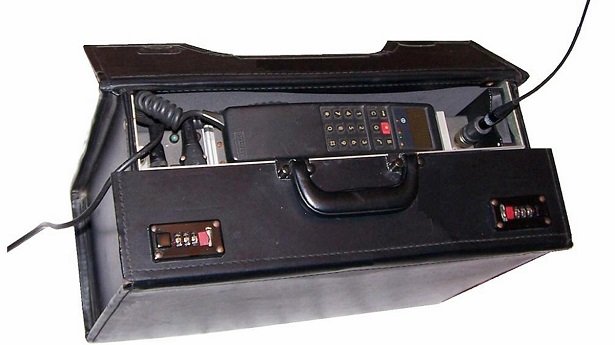
1987 г. Nokia Mobira Cityman 900
Быстрее всего отреагировала мало кому известная тогда финская компания Nokia. Где-то с середины шестидесятых она разрабатывала различные устройства связи для военных и смогла оперативно отреагировать на идею «Моторолы» и запустить собственный проект Mobira Cityman 900. Ничем действительно революционным он отличался. Он был даже похуже DynaTAC, номеров в памяти помещалось только восемь, а заплатить за него надо было примерно 4,5 тысячи долларов. Несмотря на все это продавался он очень хорошо. Его даже подарили Горбачеву, чтобы он немного попугал товарищей по партии звонком из Хельсинки.
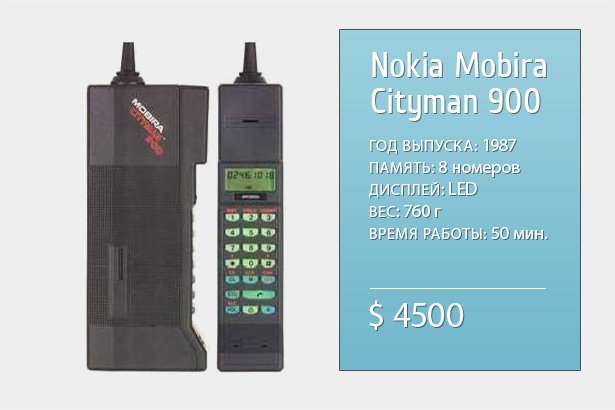
1989 г. Motorola MicroTAC 9800х
Прошло чуть больше года и «Моторола» смогла создать первый мобильный телефон, которые не требовал накаченного бицепса и небольшой тележки. Motorola MicroTAC создавали с таким расчетом, чтобы он помещался в карман рубашки и даже не сильно оттягивал его (всего 350 грамм). Его уже нельзя было использовать как гантель, а можно было просто носить с собой. За что его тут же полюбили актеры, политики, бизнесмены и бандиты, его замечают в нескольких фильмах и телесериалах. Функционально тоже был сделан шаг вперед: появилась телефонная книжка, прямо из которой можно было набрать абонента. Всего на свет появилось 37 его модификаций, последняя в 1998 году.
<br />
1990-91 гг.
Следующие два года пронеслись без заметных событий. Нет, компании не сидели сложа руки, подсчитывая доходы. Они занялись не менее важными делами: запускали первые сети, согласовывали стандарты связи и согласовывали все это с властями. Но интересно все это только специалистам. А мир пока привыкал к новым возможностям. Впрочем, надо честно сказать: пока мобильные телефоны так и оставались очень дорогими игрушками, которые покупали ради статуса. Впрочем, вскоре все изменилось.
1992 г. Nokia 1011
Долгое время реальной конкуренции у Motorola MicroTAC не было. Первой бросила вызов снова Nokia. Дело не только в том, что новый Nokia 1011 был небольшим, это был первый девайс под стандарт GSM 900.Функционально и технически он практически полностью соответствует мобилке «Мотороле», разве что дисплей все уже был MonoLCD, а разговаривать по нему можно было уже полтора часа. Главное его достоинство – это относительно низкие цены. Всего-то 1500 долларов!
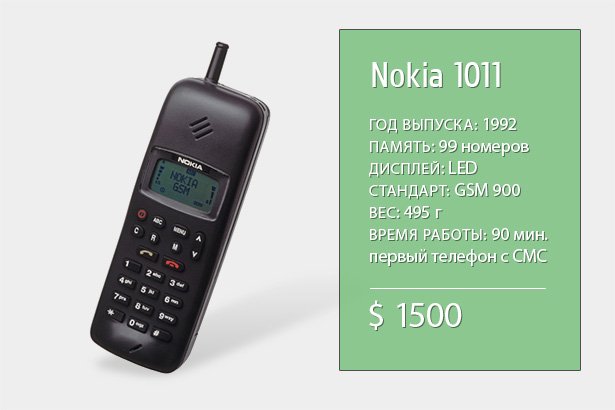
1993 г. Siemens S1
Этот год можно считать переломным. Лидеры сделали паузу и засуетились догоняющие. Так компания Bell South показала, по сути, первый коммуникатор. Кроме обычных функций телефона у него был органайзер, он мог принимать факсы и работал с e-mail. Был только один минус – он был очень тяжелым (1 килограмм!). Тогда же компания IBM представила первый в мире смартфон с сенсорным экраном – Simon. Как ни странно, но все эти инновационные устройства так и не нашли своей ниши и быстро потерялись. Больше запомнились другие новинки. В первую очередь стартовали продажи Siemens S1. Это была первая «трубка» компании, и она сразу выделялась временем автономной работы. В режиме ожидания он работал сутки, а разговаривать можно было 2,5 часа. Представляется, можно было оставить зарядку дома.
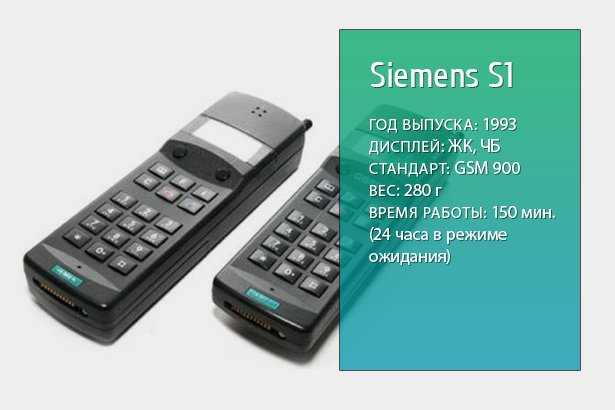
1994 г. Benefon Beta
Benefon Beta, который только показали публике, мог провести в ожидании вообще четверо суток, но запомнился он другим. Именно в нем впервые появились часы. Идея понравилась всем, кроме часовщиков, а вот сама модель распространения почти не получила, сейчас даже изображение найти сложно.
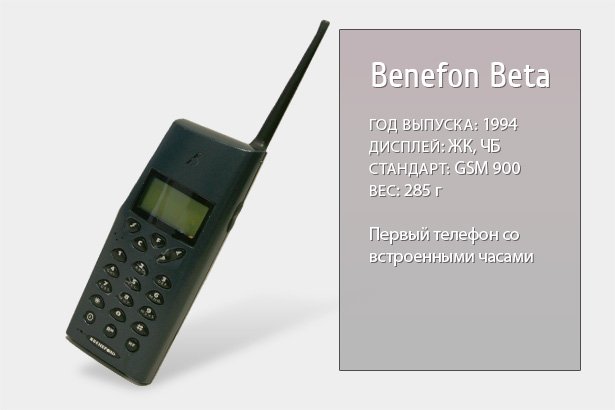
1995 г. Nokia 2110
В 1994 году отрасль стала на ноги и оглянулась по сторонам, а затем понеслась вперед, уже почти не останавливаясь и не обращая внимания на мировые экономические кризисы, войны и прочую ерунду. И во многом это произошло благодаря Nokia 2110. Модель стала хитом и успешно продавалась лет пять.
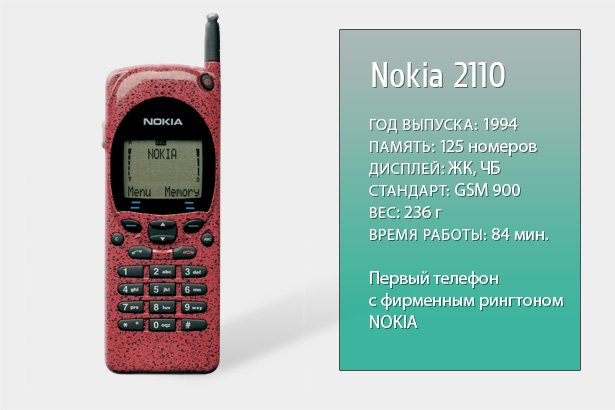
Кроме приятного и солидного дизайна, виброзвонка, телефон был еще намного дешевле конкурентов, за это в него влюбились не только буржуа, но и средний класс.
<br />
1996 г. Motorola StarTAC
Снова выстрелила Motorola. Она выпустила на рынке первую «раскладушка» Motorola StarTAC. Если моноблоковая Nokia 2011 была популярна в основном в Европе, то эта модель завоевала Северную Америку. Там она продавалась вплоть до 2000 года. Более того, вспоминая славное прошлое, его дважды пытались возродить в 2004 и 2007 годах, но уже без такого успеха. Любовь американцев объяснялась доступностью, небольшими размерами и дизайном.
<br />
1997 г. Siemens S10
Новинка Siemens 1997 года – модель S10, не стала такой популярной, как две предыдущие. Однако у нее было одно очень важное достоинство. Именно тут покупатели впервые увидели цветной дисплей. У него было всего пять строк, но все же в этой технологической гонки в первый и последний раз выиграли немцы. Поставили сюда и хороший аккумулятор. Siemens принадлежит и другое достижение. Именно они первые придумали телефон для экстремалов и сделали его на именно на базе S10. Модификацию назвали Active и с помощью прорезиненных вставок в корпусе обеспечили ему защиту от влаги, пыли и ударов.
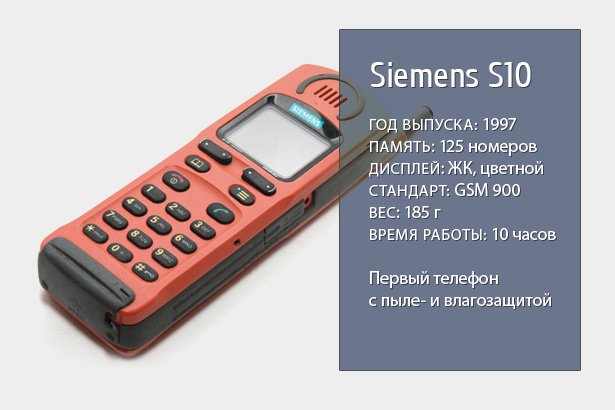
1998 г. Nokia 9000/9110
Собственно, серия смартфонов, сама компания предпочитала называть их коммуникаторами, появилось у Nokia еще в 1996 году. Надежды на 9000 были очень большими, но продажи просто-напросто не пошли. Объяснялось это двумя причинам: они были слишком тяжелые (почти 400 грамм) и дорогие (1000 долларов).
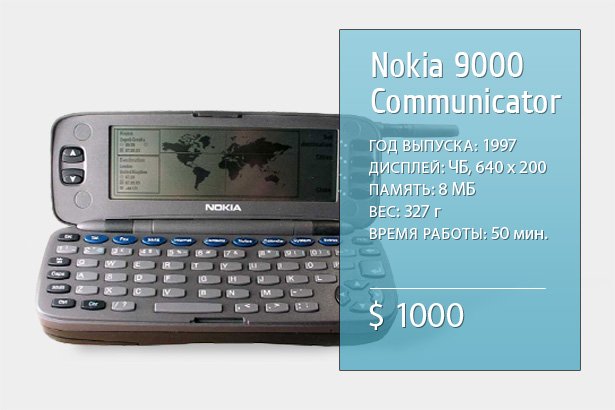
Сначала компания снизила цены, к нему появился определенный интерес. Затем разработчики серьезно поработали над внутренностями, сделав его легче на 140 грамм – так появился 9110, который продавался уже намного лучше. Еще лучше пошли дела после модернизации в следующем году, когда среди функций появился WAP. Впрочем, все это было только первым шагом к появлению смартфонов. У этих моделей не было самого главного – устанавливать свой софт сюда было нельзя.
<br />
Этой моделью можно подвести черту под первой частью истории мобильных телефонов. До этого все эти замечательные устройства просто звонили, плюс что-то еще. Но теперь в них со всего разбега въехал Интернет. И простые трубки превратились в нечто совершенно невообразимое.
Часть вторая. Эра новых технологий.
1999 г. Nokia 7110
Первый шаг в эту эпоху сделала компания Nokia. Она и до этого придумывала новые форматы и внедряла перспективные технологии. Но появление WAP – стало просто судьбоносным. Конечно, сама технология не позволяла получить полноценный доступ к Интернету, но и это сразу привлекло внимание покупателей. Кроме того, телефон получил программную платформу Series 40, которая заметно расширяла его возможности. Набор функций для того времени был весьма впечатляющим. В результате, все вылилось просто в безумную популяцию.
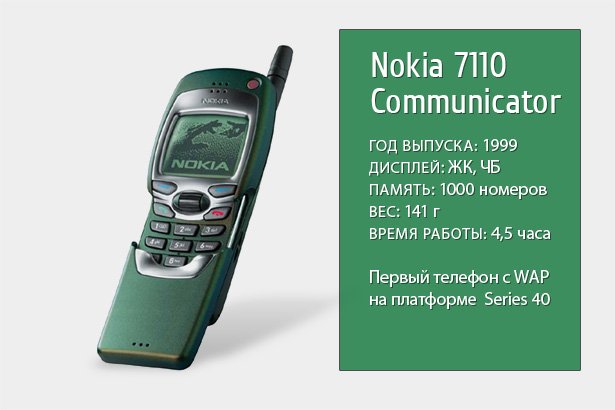
2000 г. Siemens SL45
В этом году запускали очень много моделей, но как часто это бывает в переломный момент, большинство разработчиков еще не нащупали правильный путь развития. Зато отличились специалисты от Siemens: в новой модели SL45 появился MP3-плеер и даже слот расширения памяти с помощью карты ММС. Это просто лебединая песня компании. В последствие они ударились в странные эксперименты и вылетели из рынка. А у Siemens SL45 поклонники были даже спустя десять лет. Также на рынке мелькнули и первые Samsung’и, которые, правда, ничем особенным не запомнились.
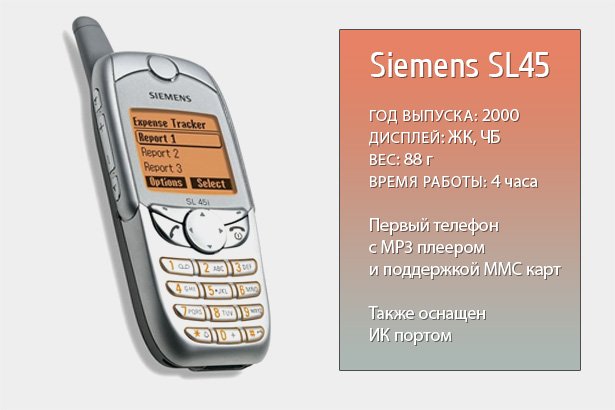
2001 г. Ericsson T68
Снова небольшой застой, но в этот раз интересных новинок оказалось на удивление много. Выстрелила Samsung с необычным женским телефоном SGH-A400, появилось несколько интересных моделей от Nokia. Но особенно удачным год стал для Ericsson. Вначале компания отметилась небольшим T39, в котором впервые появился Bluetooth. Затем хорошо пошел самый маленький на тот момент T66. В финале же самым популярным телефоном года стал золотистый T68, куда впихнули практически все актуальные на тот момент технологии и функции
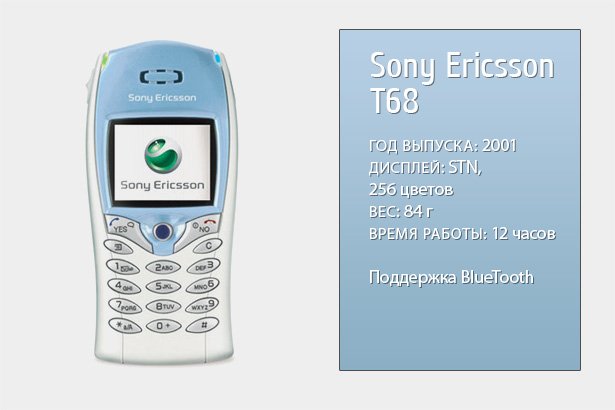
2002 г. Nokia 7650
Первая камера в телефоне появилась в Sanyo SCP-5300, но качество снимков у нее было очень низкое, а сам бренд очень слабо представлен. В общем, почти все его пропустили. По-настоящему о преимуществах встроенной фотокамеры задумались только с появлением Nokia 7650. Камера и тут всего на 0,3 мегапикселя, но все же, различить снятое можно. В этом телефоне появилась программная платформа Series 60, которая превращала его в полноценный смартфон. Из других вкусностей: полифония, слайдер, встроенный HTML-браузер.
<br />
2003 г. BlackBerry 7210
Канадская компания BlackBerry начинала когда-то с пейджеров. С тех пор она явно тяготела к офисам, а смартфоны вначале были предназначены исключительно для рабочих будней. То есть без возможности послушать музыку, посмотреть видео или что-то сфотографировать. Обрезали почти все. Почему-то оставили только несколько игр. Главный упор делался на производительность железа. Внутренней памяти было 16 Мб. Это, надо признать, сработало. Телефоны очень хорошо продавались в Северной Америке, отголоски славы доносились даже в Россию.
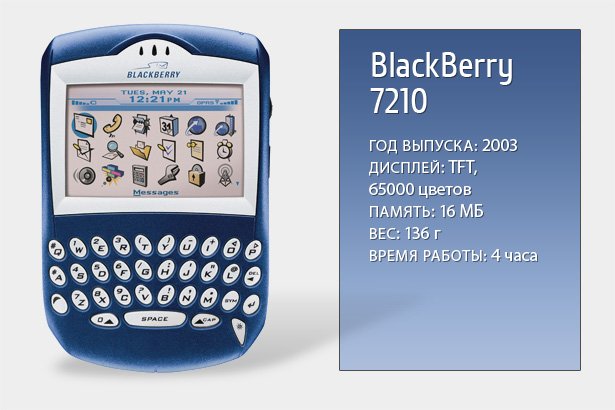
2004 г. Motorola RAZR V3
Motorola долго пыталась вернуть себе лидерство и, наконец, создала культовый телефон. Компания сразу почувствовала, что поймала удачу за хвост. Первоначально даже объявила, что девайс имидживый и обойдется дороже. Но затем, все же, сбросила цены и продала сразу пятьдесят миллионов. Начинка у него была обычной для своего времени, стоит отметить только WAP 2.0 и приличный дисплей. Покупателей подкупал оригинальный и интересный дизайн. На его фоне потерялся и Nokia 7610 с 1-мегапиксельной камерой, и мощный Sony Ericsson P910.
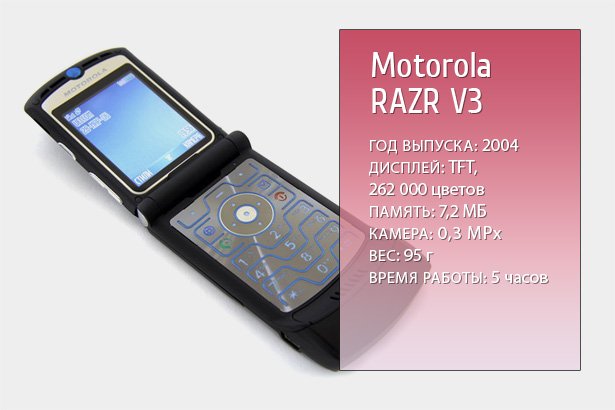
2005 г. Sony Ericsson K750
Определить победителя в этом году довольно сложно. Разве что по очкам. Motorola RAZR V3 прошлого года получил новую модификацию. HTC начала продажу весьма удачной модели Universal. Nokia пробивала дорогу смартфонам мощным 6680. Приз года получает все же Sony Ericsson K750 исключительно благодаря фотокамере на 2 мегапикселя и хорошей производительности «железа». Самое интересное, что сражение этой «большой тройки», уже чрез пару лет сменится их капитуляцией перед новыми игроками. Как раз в 2005 году компании наглядно продемонстрировали, почему это произошло. По какой-то причине все они старались выложиться на каком-то одном направление. Это работало, пока Apple не догадалась предложить универсальный продукт.
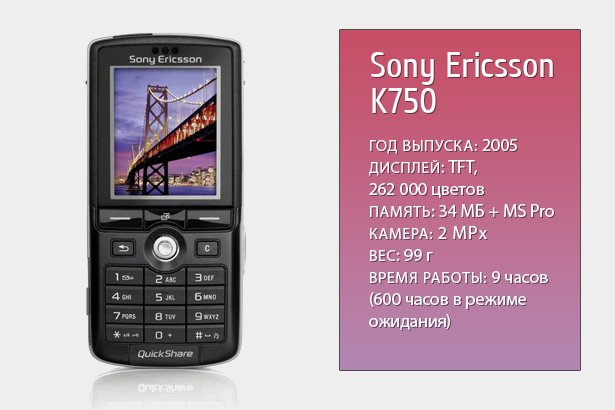
2006 г. Nokia N73
Компания Nokia снова подготовила отличный смартфон. Симпатичный моноблок, с очень богатым функционалом. Особенно если это касалось мультимедийных возможней: N73 проигрывал музыку, видео, мог записать ролики. Для желающих была даже возможность просмотра телевизионных каналов. Вот только разгуляться ему почти не дали. Уже в следующем году все только и говорили про iPhone. На его фоне железо Nokia N73 (процессор ARM9 на 220Mhz, 64 Мб оперативки и 2 Гб на microSD) смотрелись откровенно жалко.
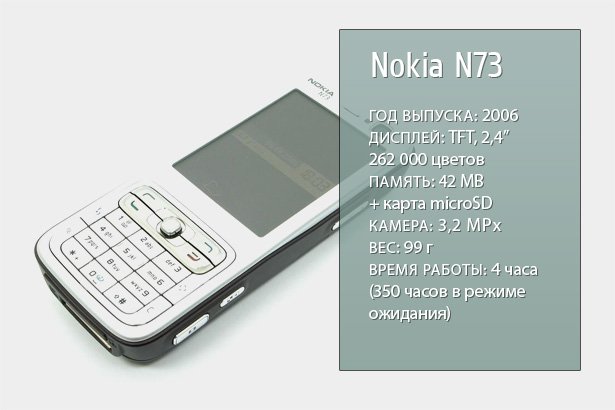
2007 г. iPhone
В этом году началось доминирование Apple. Конечно, в масштабах истории, iPhone царствовал не очень долго. Каких-то пять лет, но все это время никакой реальной альтернативы ему не было. Это привело к тому, что старые лидеры стремительно потеряли свои позиции, а некоторые вообще ушли с рынка. Почему? Секрет простой: iPhone был практически универсальным и давал максимум возможностей на момент появления. Выше приводятся характеристики весьма производительно Nokia N73. Вот только iPhone – это процессор Samsung32-bitRISCARM на 620 Мгц, 128 Мб оперативной памяти, графический процессор и встроенная память как минимум на 4 Гб. И то, четырехгигабайтную версию прекратили выпускать через два месяца, оставив только на 8 Гб. И, конечно же, сенсорный дисплей на 3,5 дюйма.
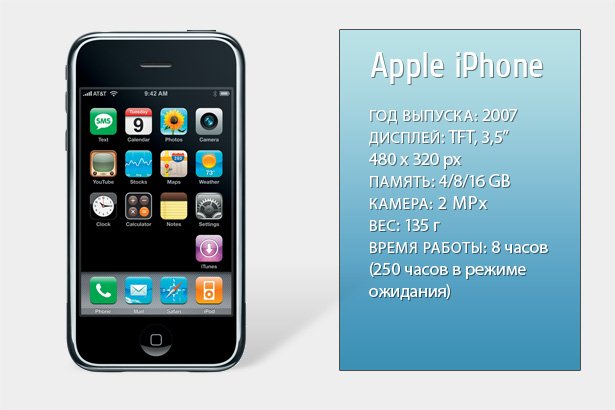
2008 г. iPhone 3G
В следующем году ситуация почти не изменилась. Apple выпустила новую модель, еще больше упрочив свое лидерство. Изменения не были кардинальными. Новый iPhone 3G немного подтянули. Добавили поддержку 3G, обновили ОС до IOS 2.0 и добавили GPS, которого явно не хватало. Этого оказалось достаточно, чтобы не подпустить конкурентов, которые уже отправились от нокаута и начали реагировать на происходящее. Например, Nokia выпустила симпатичные E90 и N95, LG активно продвигала Prada KE850 с сенсорным экраном, а про другую свою модель LG Voyager вообще говорила, что у него есть практически все функции iPhone..
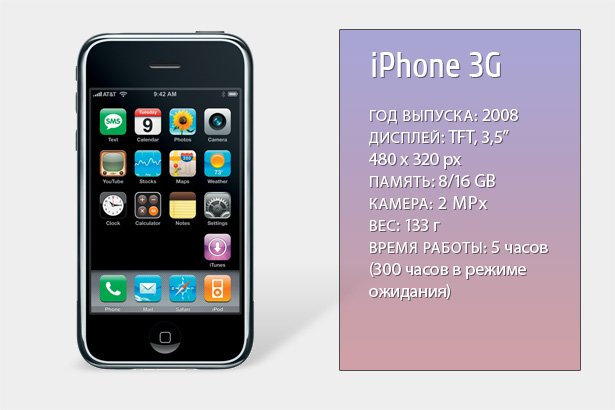
2009 г. iPhone 3GS
Очередное обновление iPhone сохранило отрыв от конкурентов. Хотя iPhone 3GS называли промежуточным шагом, необходимым перед появлением четвертого поколения, модернизация была весь существенной. По сути, поменяли всю аппаратную часть: процессор поставили чуть быстрее (ARM Cortex-A8 833 МГц), графический процессор тоже новый (PowerVR SGX535 на 150 MHz), оперативку увеличили в два раза, до 256 Мб. Обязательную теперь фотокамеру тоже поставили чуть лучше, а IOS обновили до 3.0. Конкуренты уже откровенно барахтались, занимая какие-то отдельные сегменты рынка.
2010 г. iPhone 4
Наконец, у iPhone появился конкурент. Корейцы из компании Samsung создали достойного соперника – Galaxy S. Чтобы подчеркнуть это они даже презентацию провели в один день (24 июня) с Apple, которая представляла четвертую версию своего смартфона. Характеристики их оказались в целом очень похожими, в чем-то, например, в мониторе Phone немного уступал. Но свалить того с трона Samsung’у не удалось. Во многом благодаря высокой репутации самой Apple.
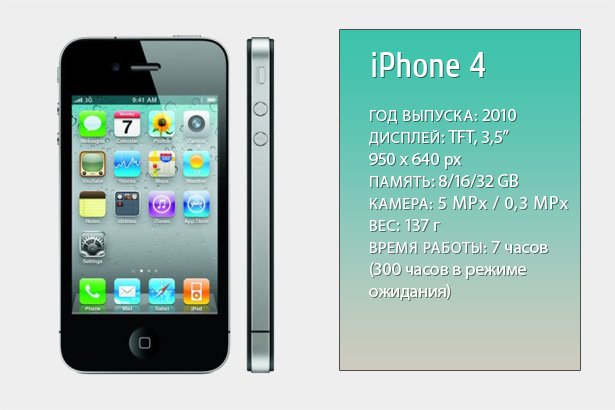
2011 г. iPhone 4S
В этот раз победа iPhone условная. Samsung создал телефон, который по характеристикам оказался лучше. И сделали это намного раньше. Презентацию Galaxy S II они провели аж 13 февраля, в то время как Apple задержала ее до 14 октября. Но даже такая фора не помогла: процессор оказался слабее, экран меньше, оперативная память в два раза скуднее. Даже батарея более емкой. Выиграло «Яблоко» только в одном показателе – количество проданных телефонов.
2012 г. Samsung Galaxy S III
Samsung получил первое место по совокупности достижений. И благодаря 60 миллионам проданных телефонов этой модели. В Galaxy S III отличное и мощное «железо»: четырехядерный процессор, полтора гигабайта оперативки, 16-64 Гб флэш-памяти и другие вкусности. iPhone проиграл заслуженно и по объективной причине. В 2011 году умер основатель и главный генератор идей Стив Джобс. Без него с новинками получалось как-то не очень хорошо. Только в 2014 году разработчикам удалось собраться и выпустить что-то стоящее.
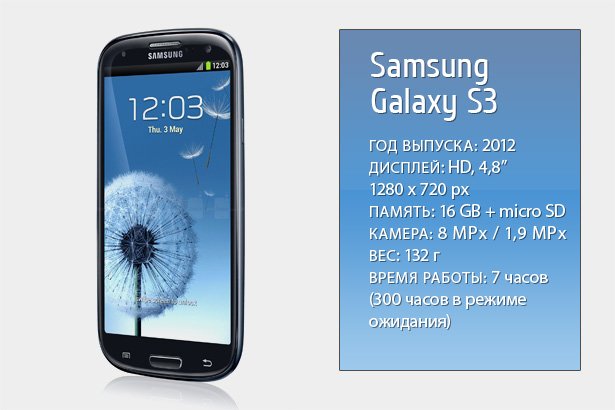
2013 г. Samsung Galaxy S4
Рецепт первого iPhone – везде, всего и много – использовал Samsung в главной новинке прошлого года Galaxy S4. Тут очень мощный процессор – четырёхъядерный Qualcomm Snapdragon 600 на 1,9 ГГц, 2 Гб оперативной памяти и Qualcomm Adreno 320 в качестве графического процессора. И как вишенка на торт – фотокамера на 13 Мп. Впрочем, в этот раз телефон не ведет борьбу в одиночестве: отличные характеристики у LG G2, Sony Xperia Z и Nokia Lumia 920.
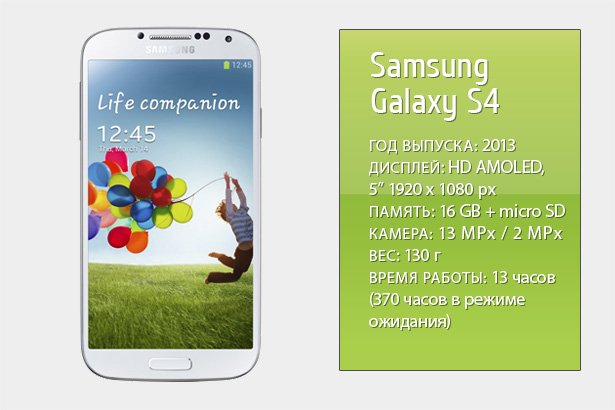
2014 г. — ? —
В этом году основное соревнование ведется снова между Apple и Samsung, но выбрать можно не только между iPhone 6 и Galaxy S5. Хорошие отзывы у LG G3, HTC One (M8) и Nokia Lumia 930. Кроме того в борьбу за лидерство активно вмешался и YotaPhone-2. И пока до конца года остался еще месяц, у каждого из претендентов есть шанс выйти на первое место.
Теорию эволюции проследил Максим Усачев
Иллюстрировал Дмитрий Шевчук

